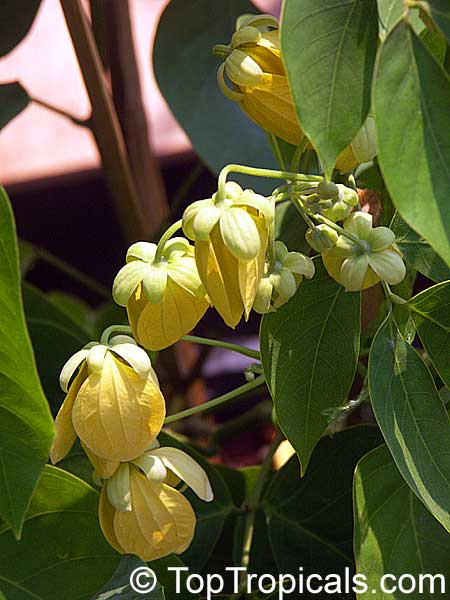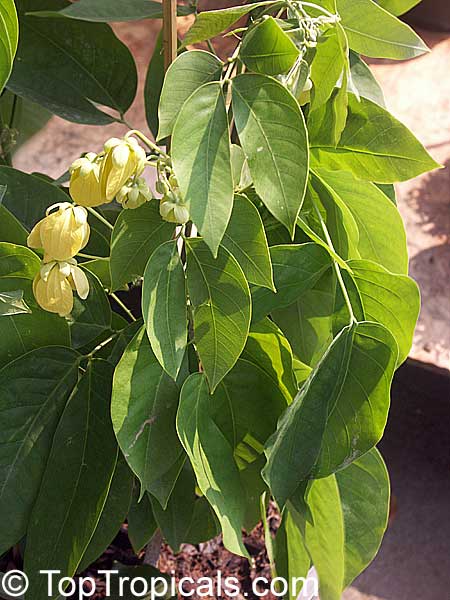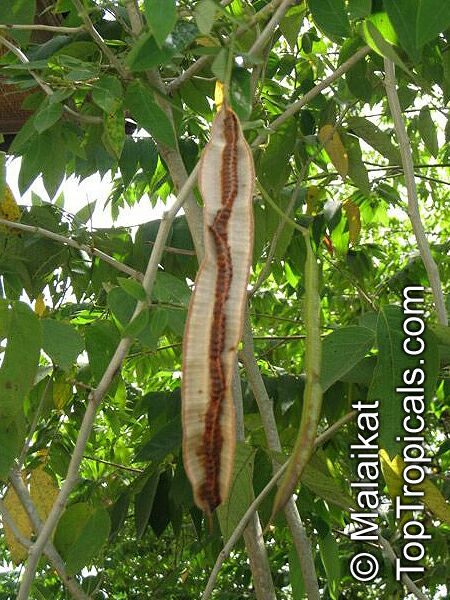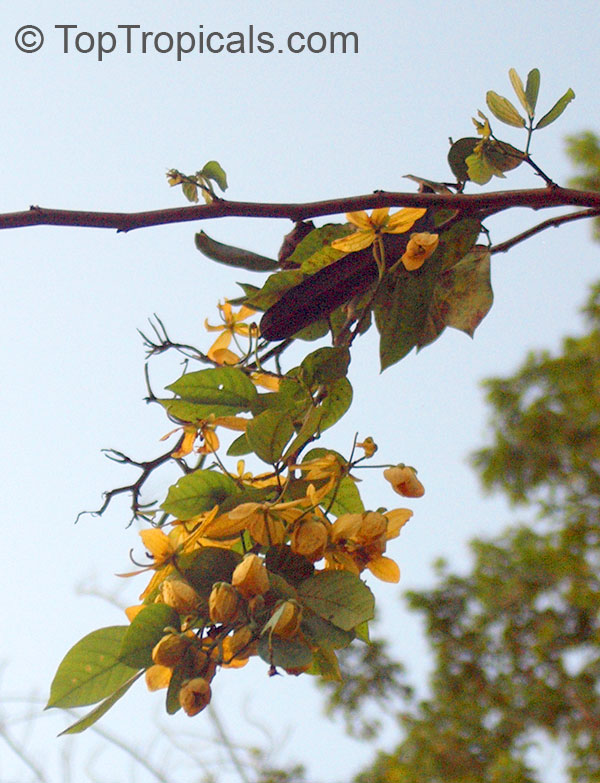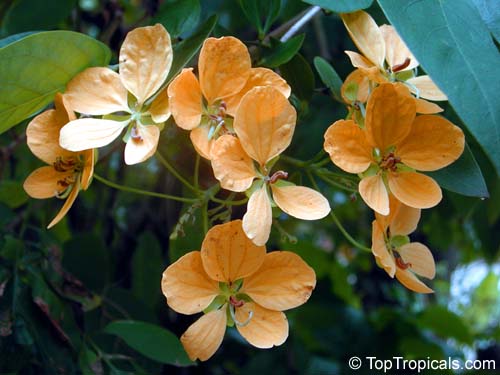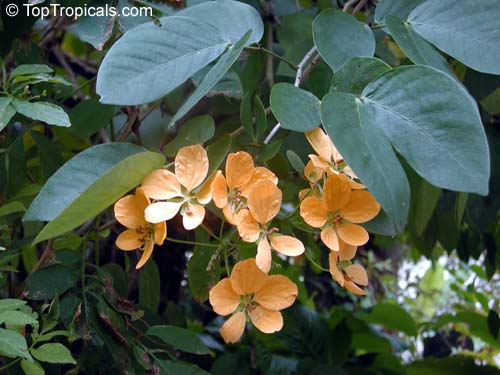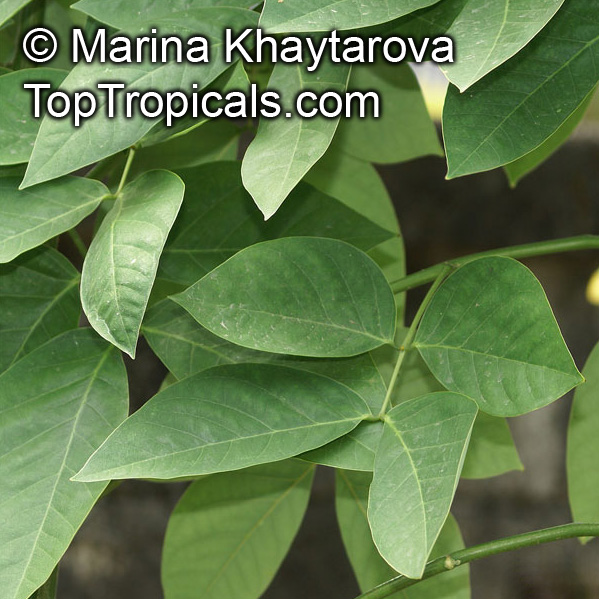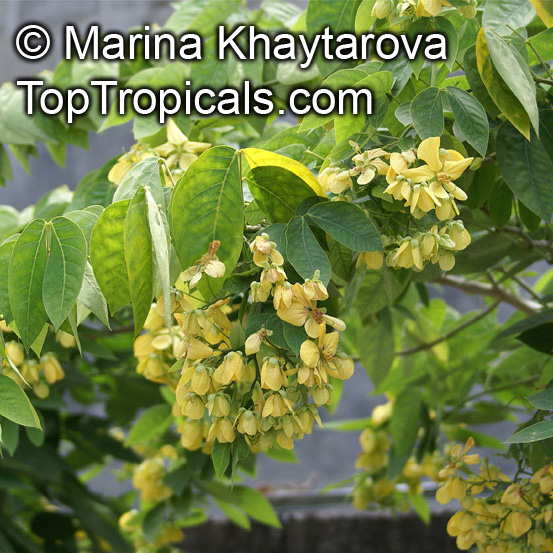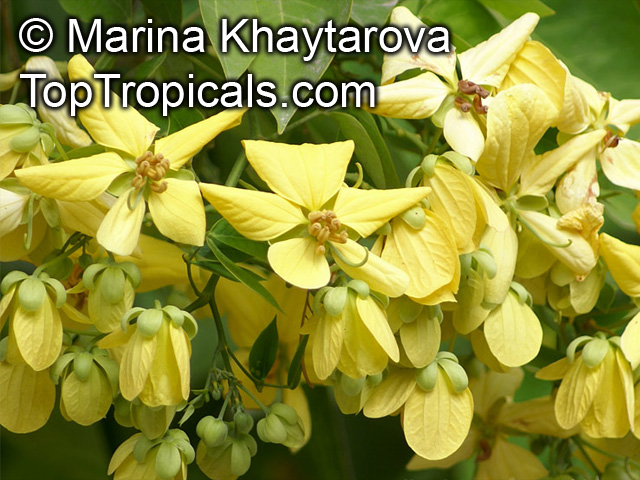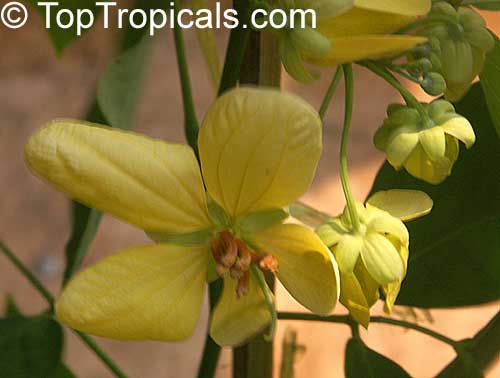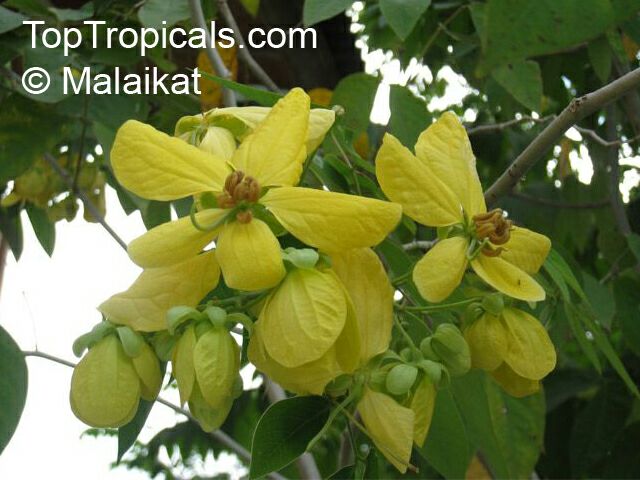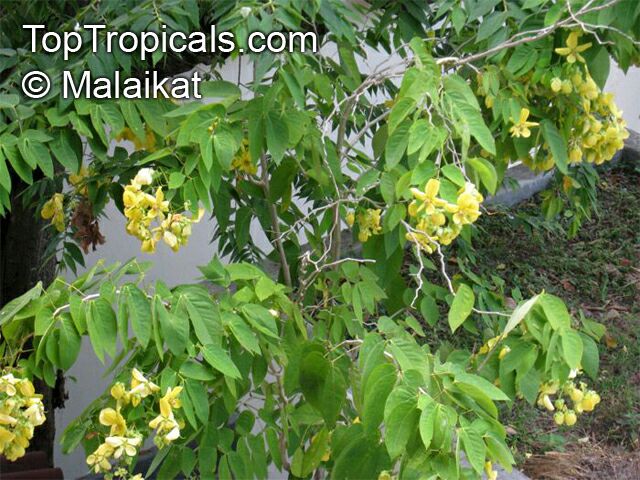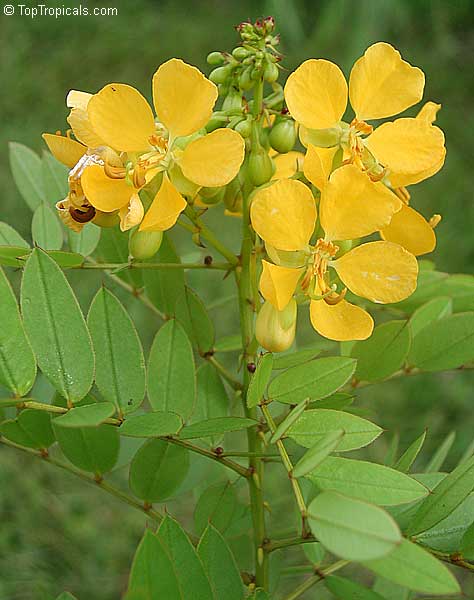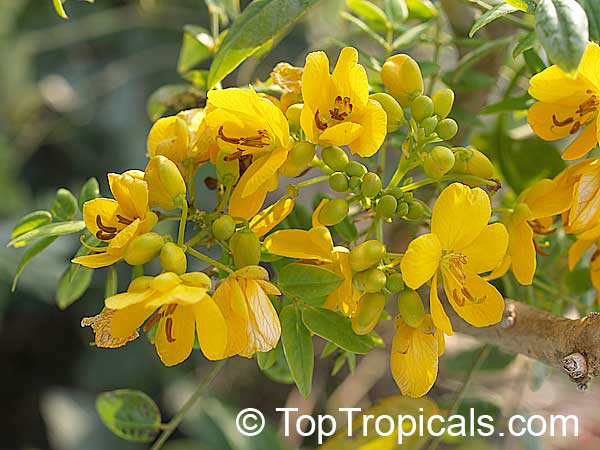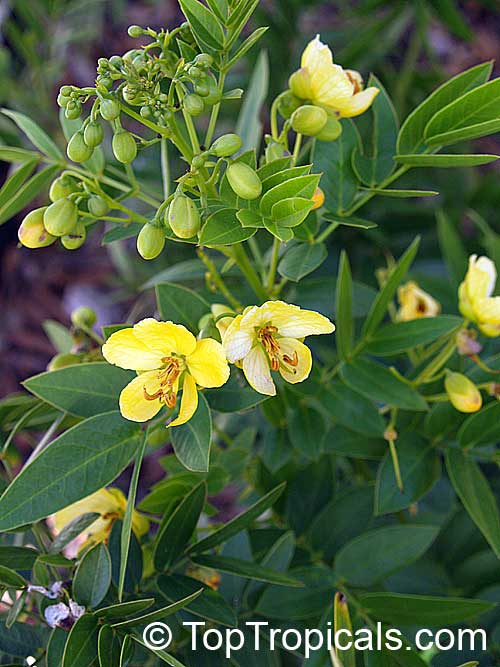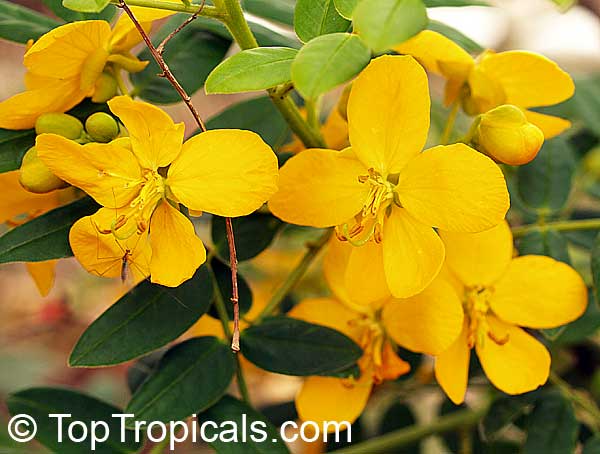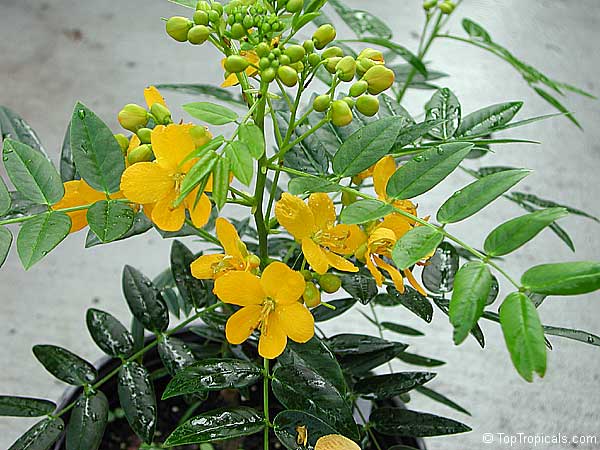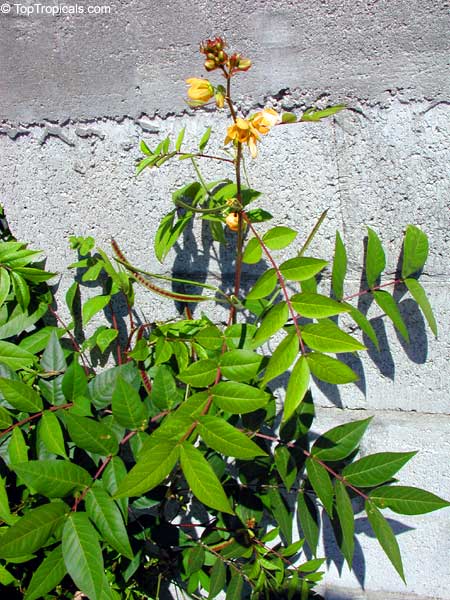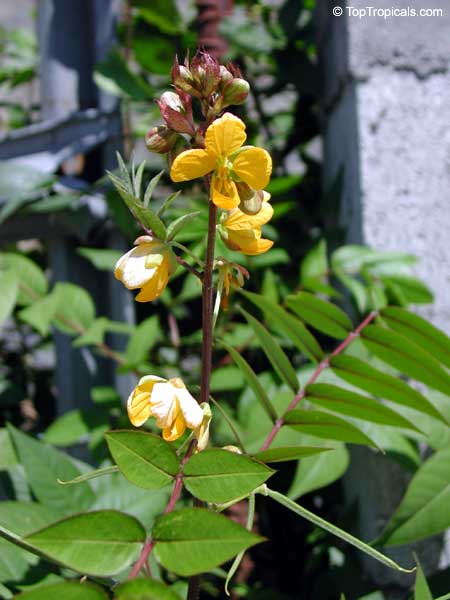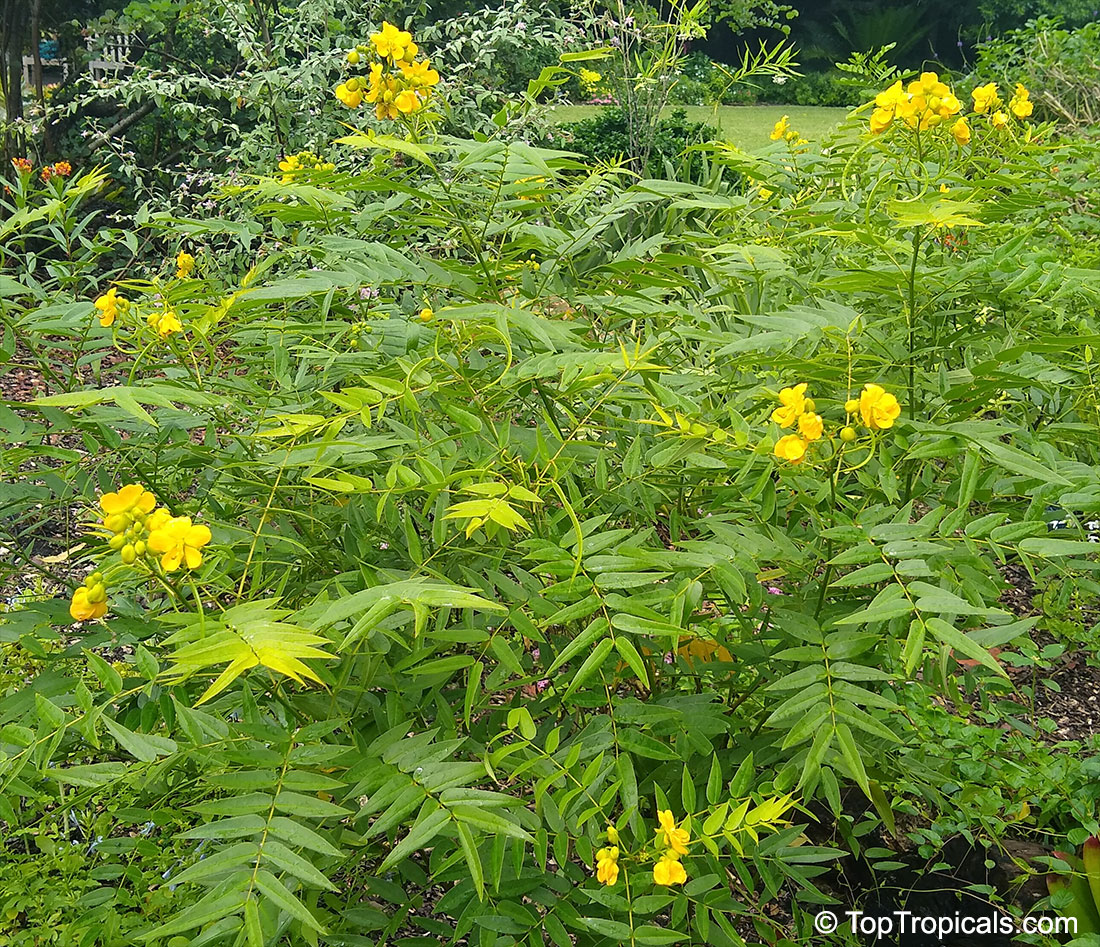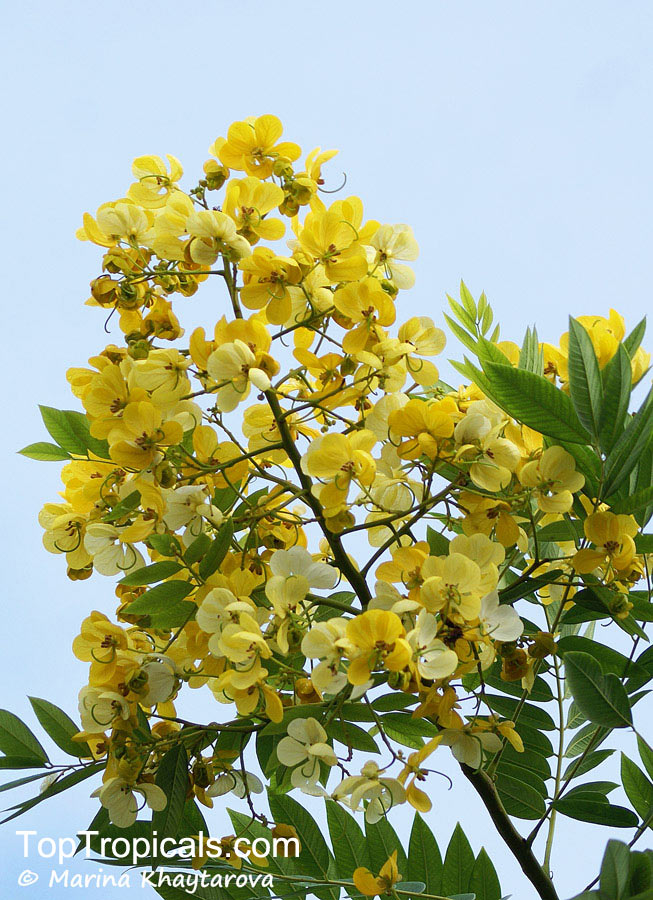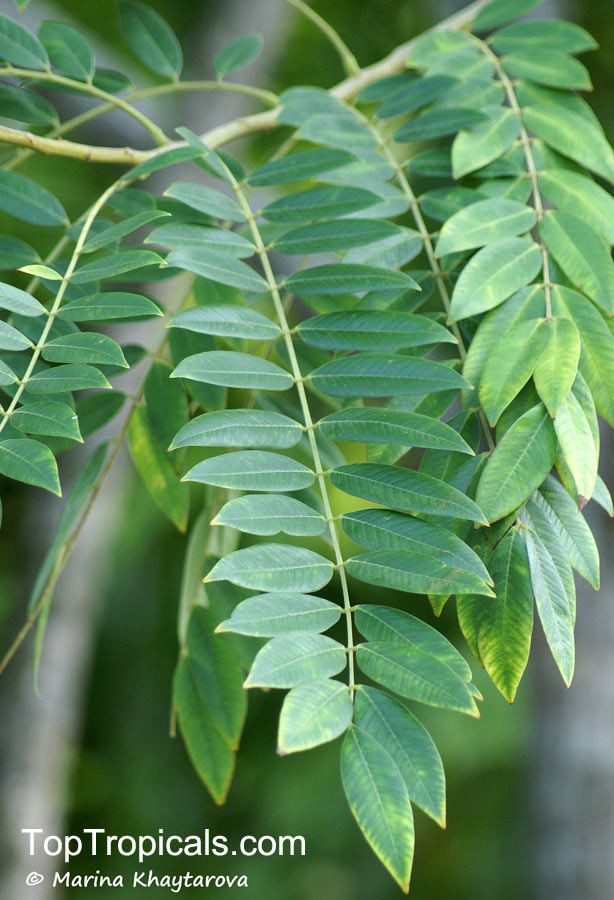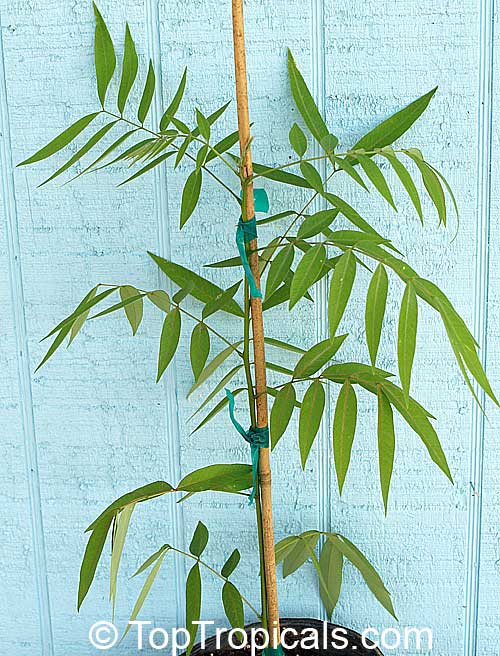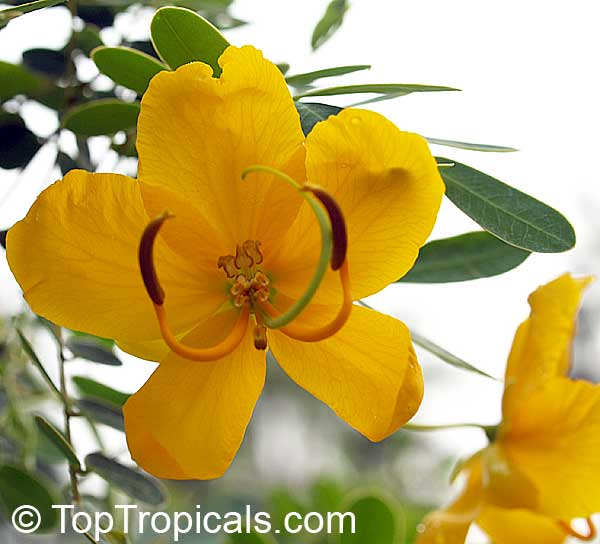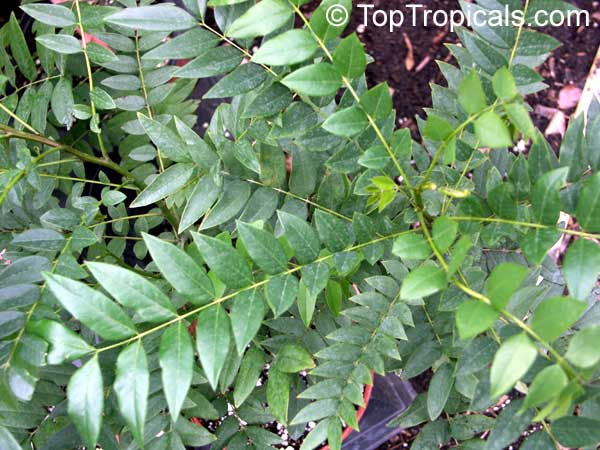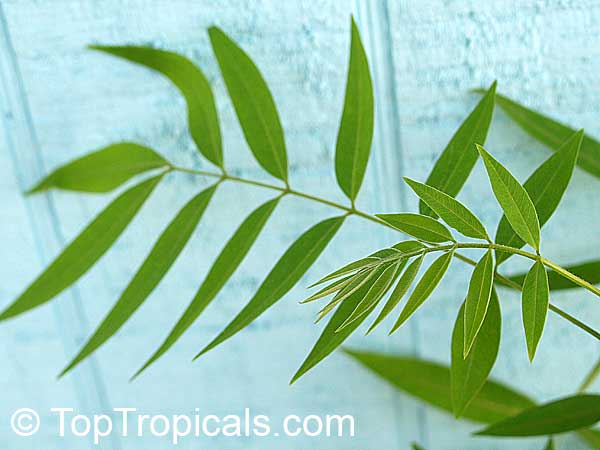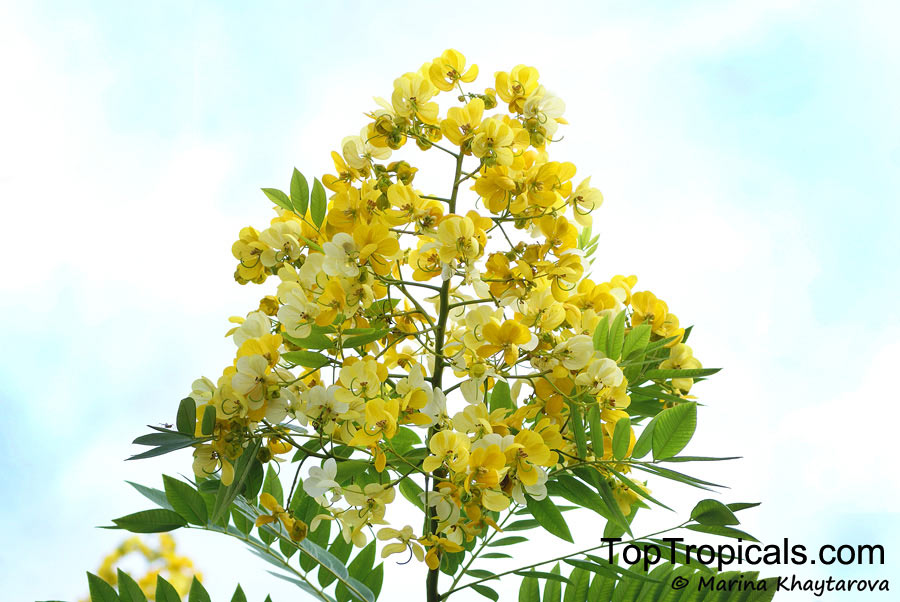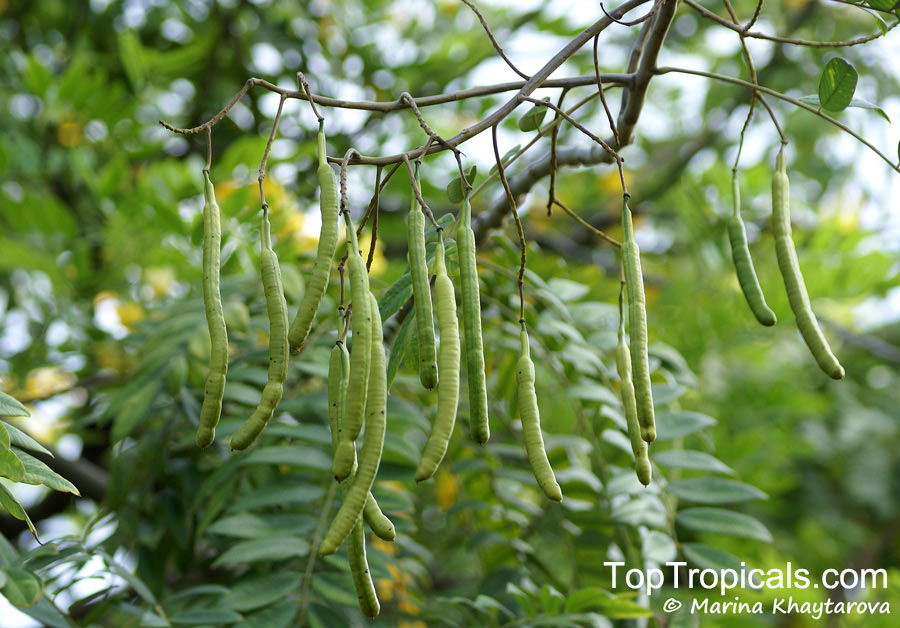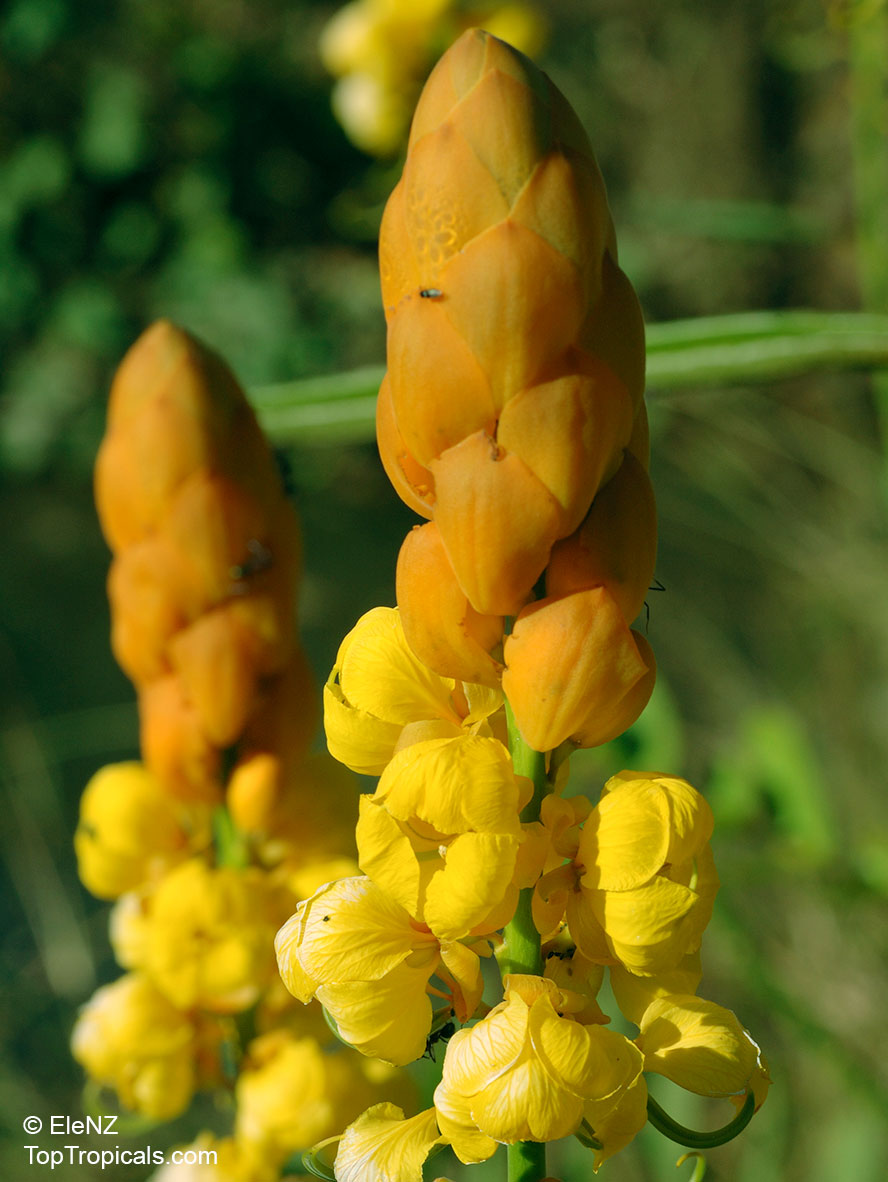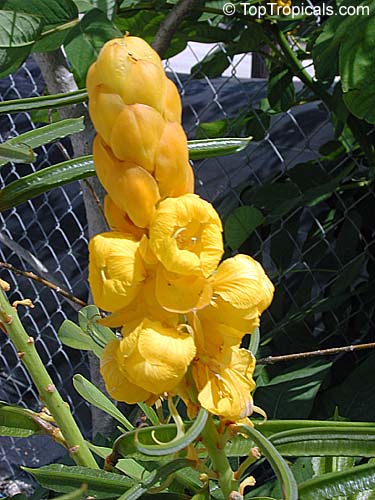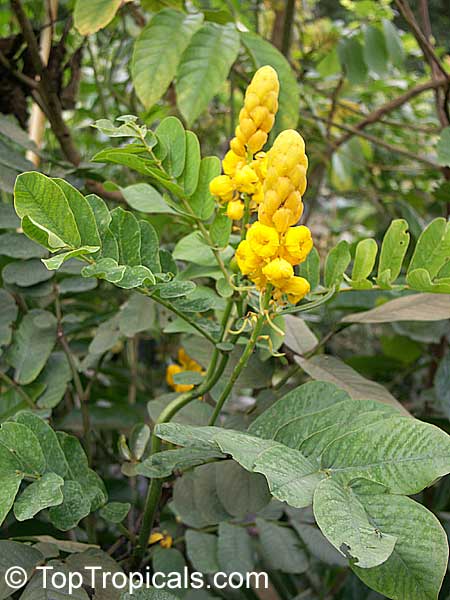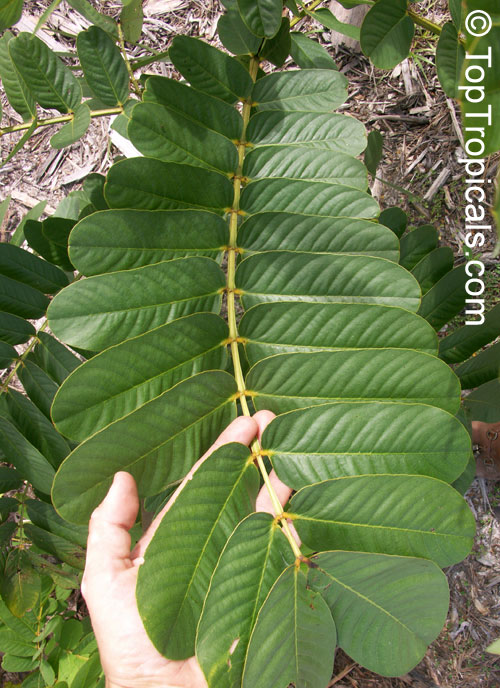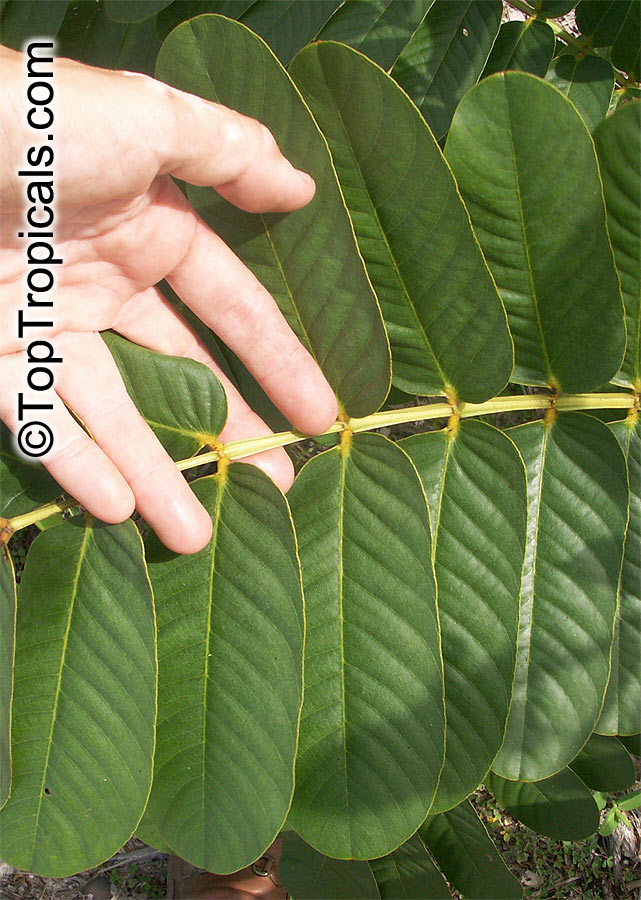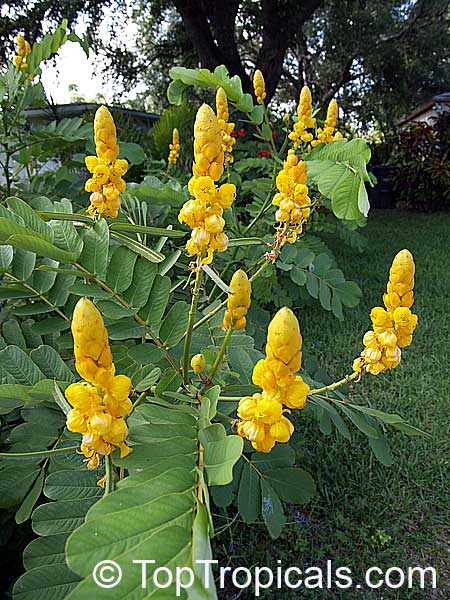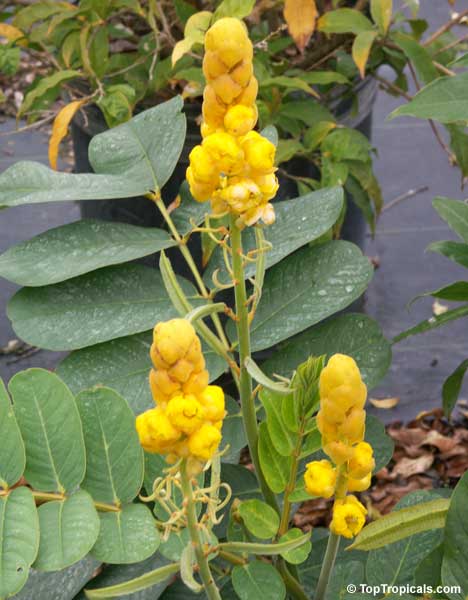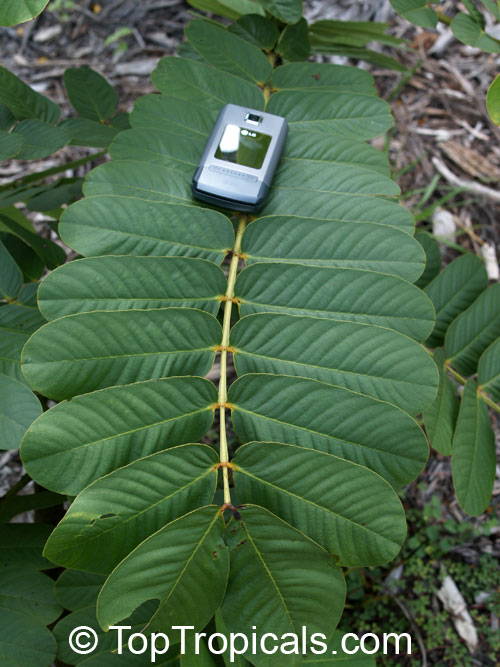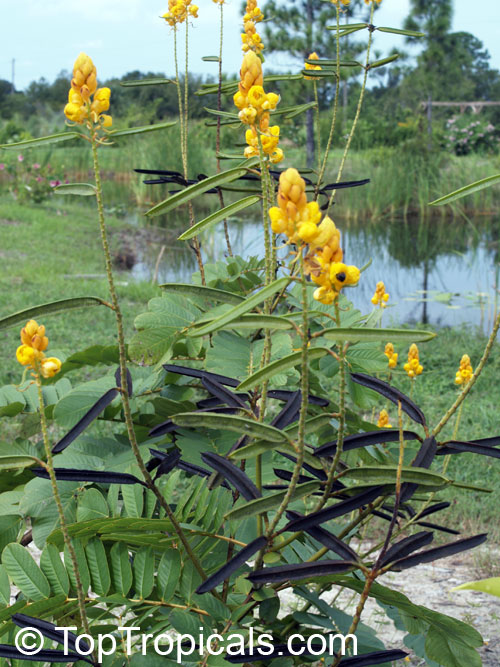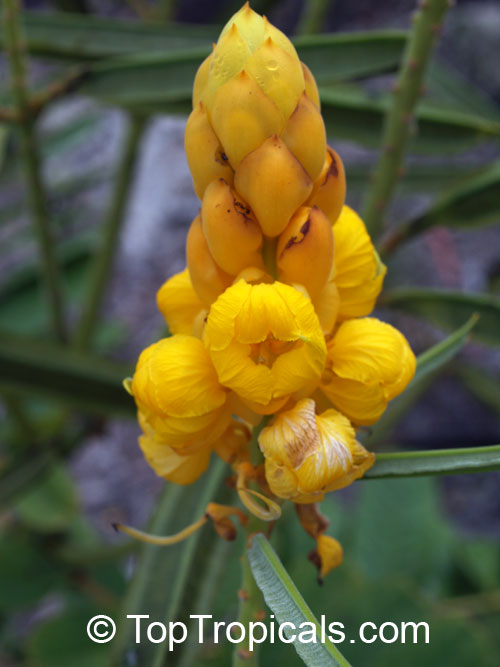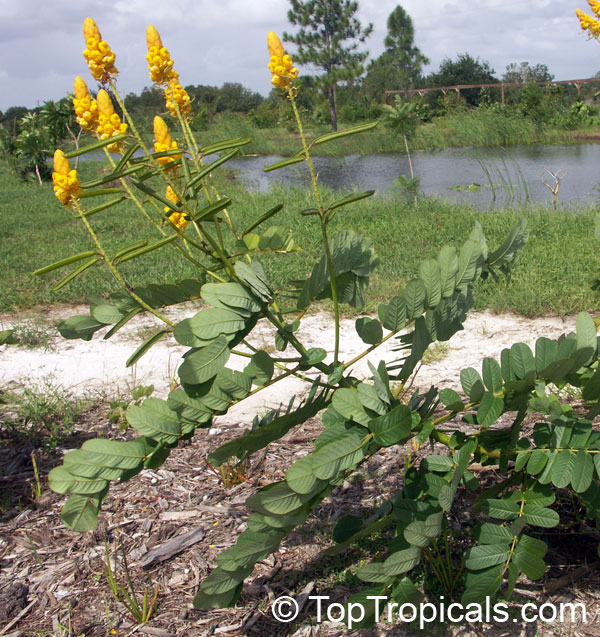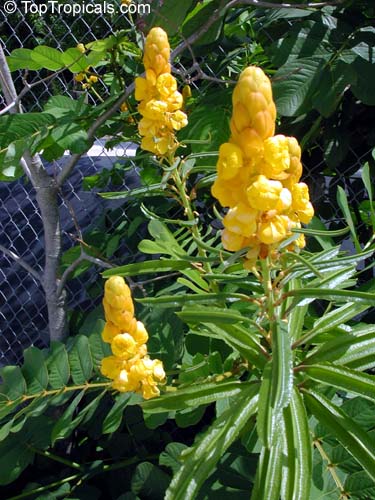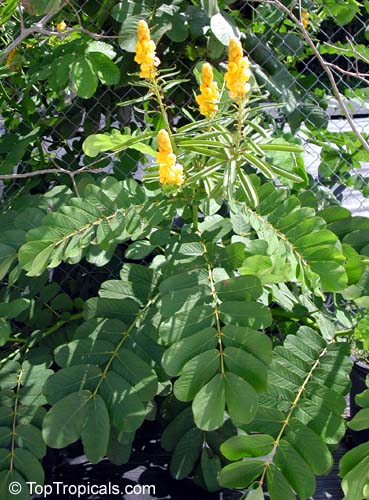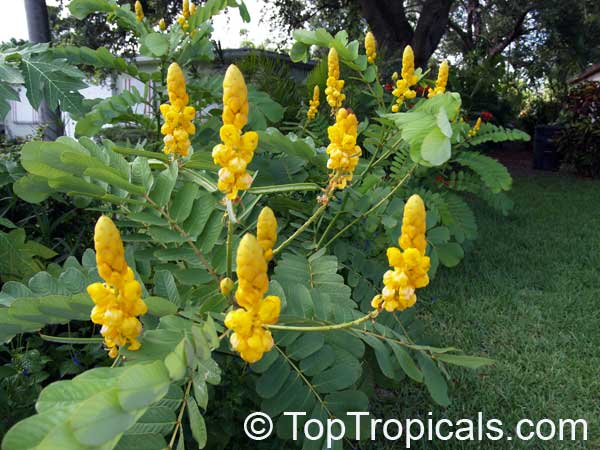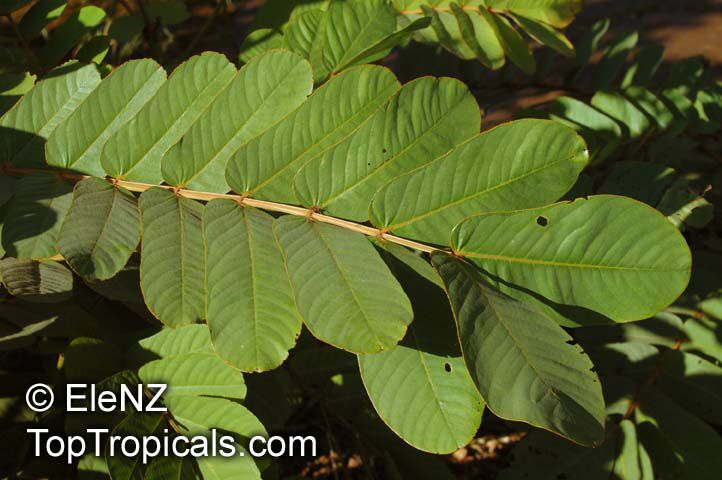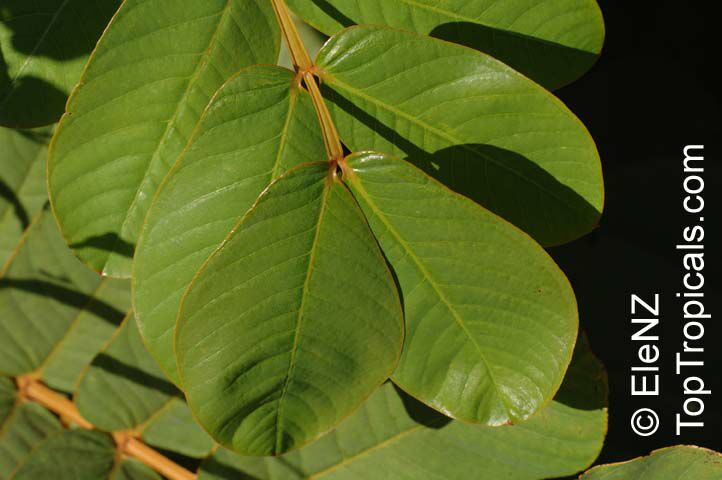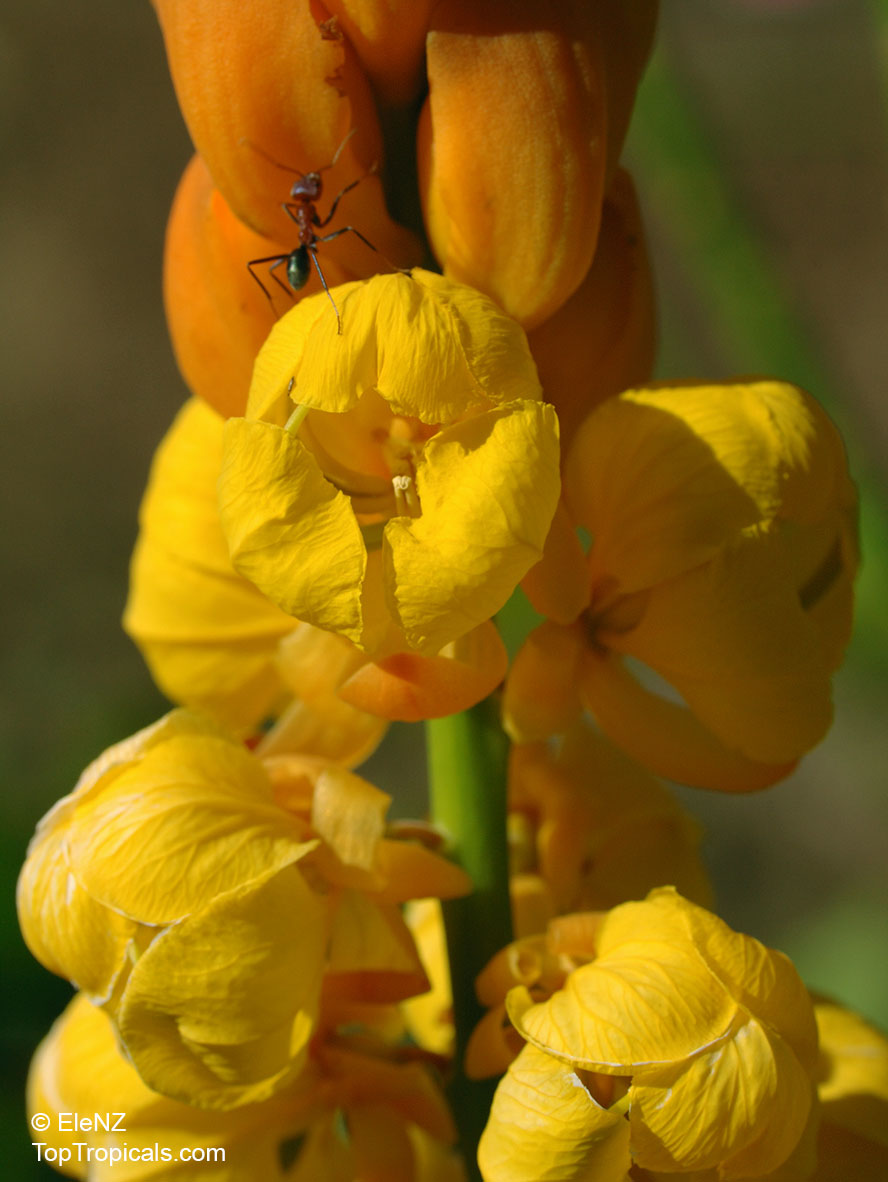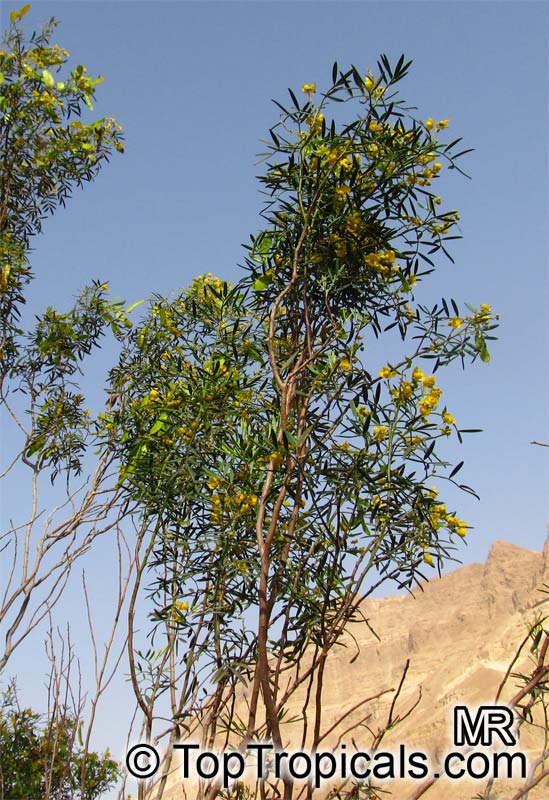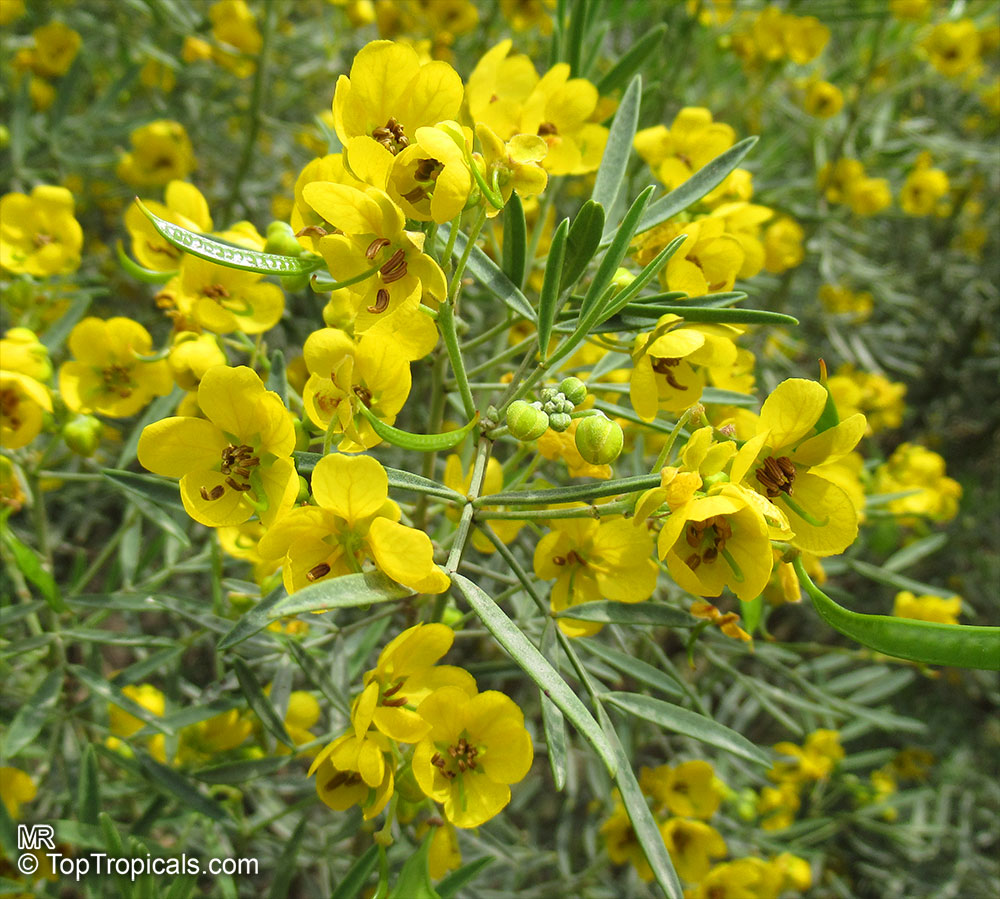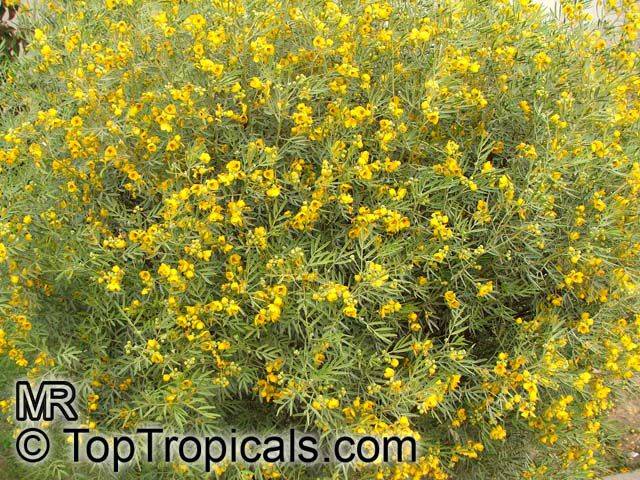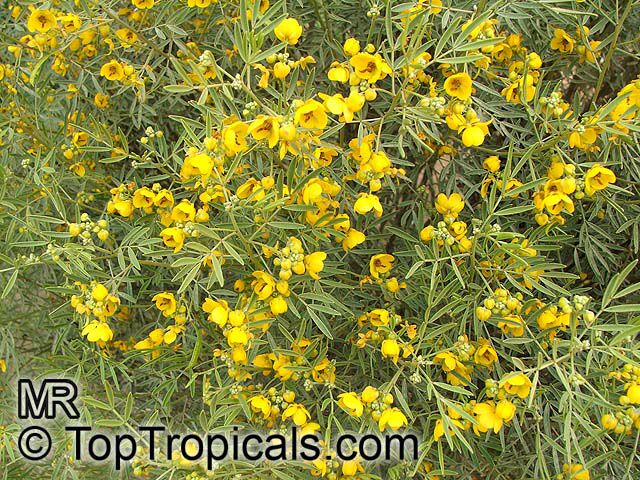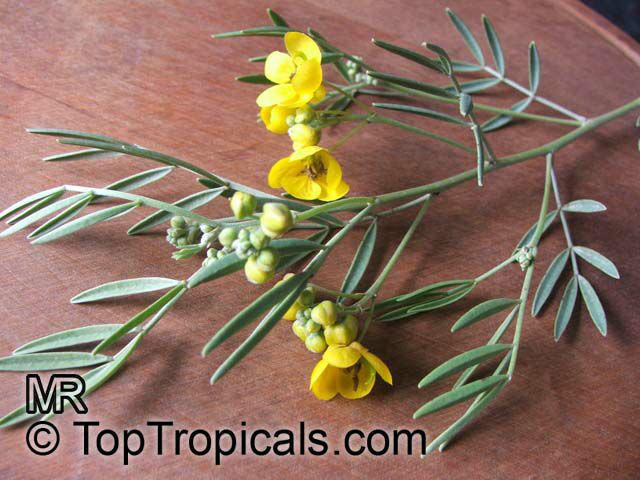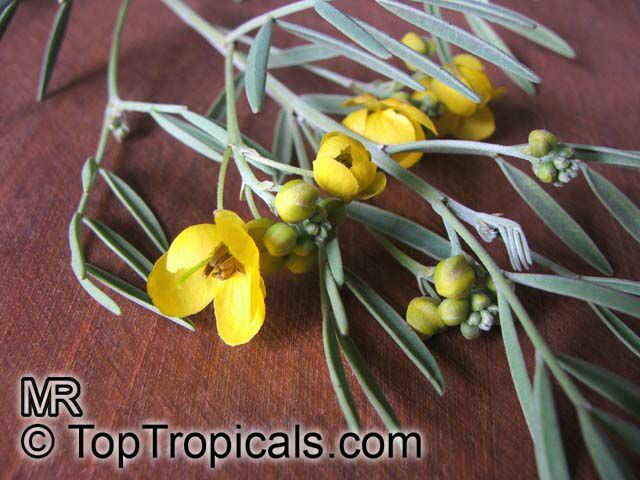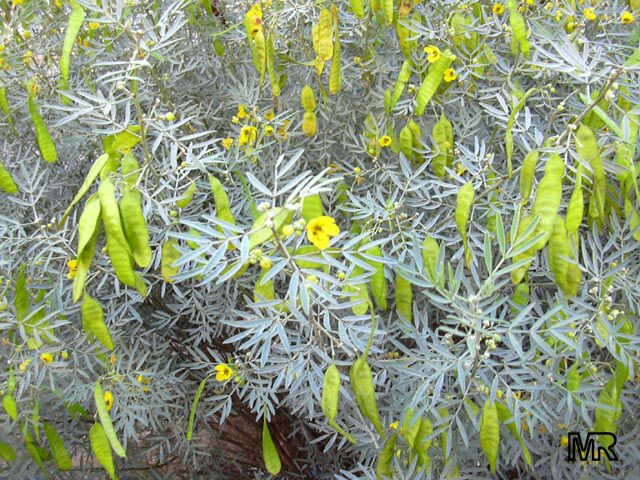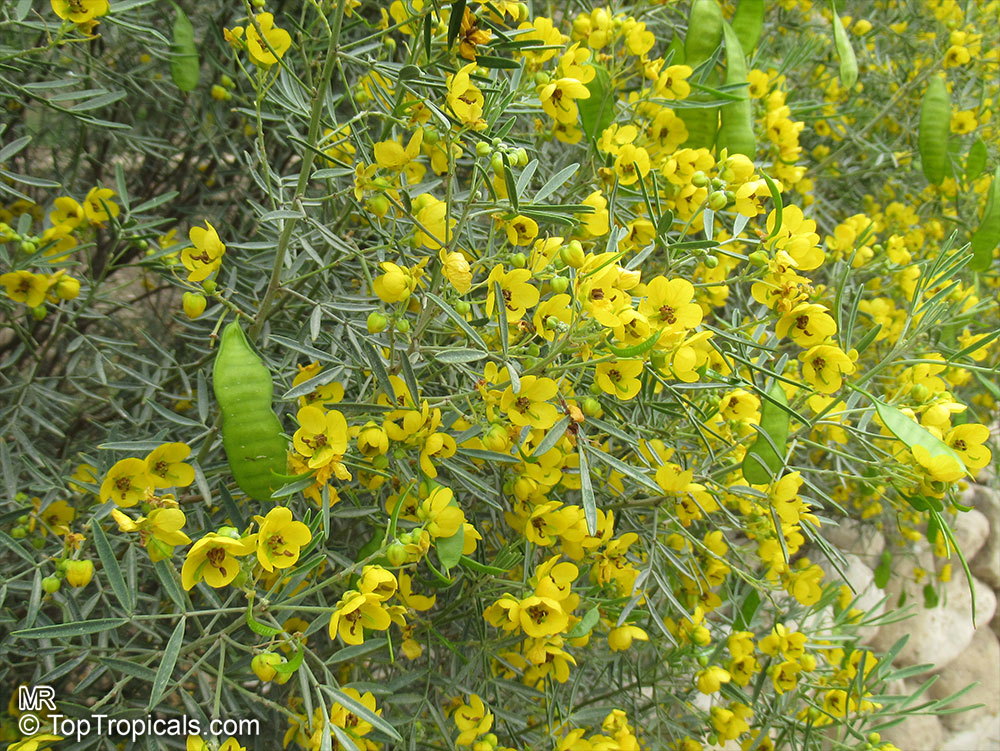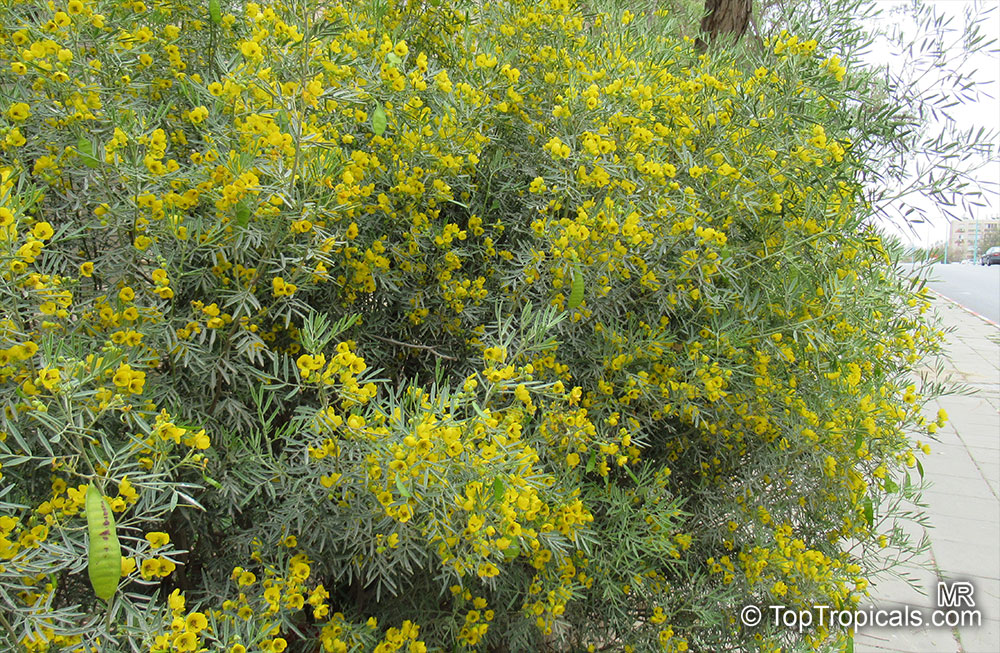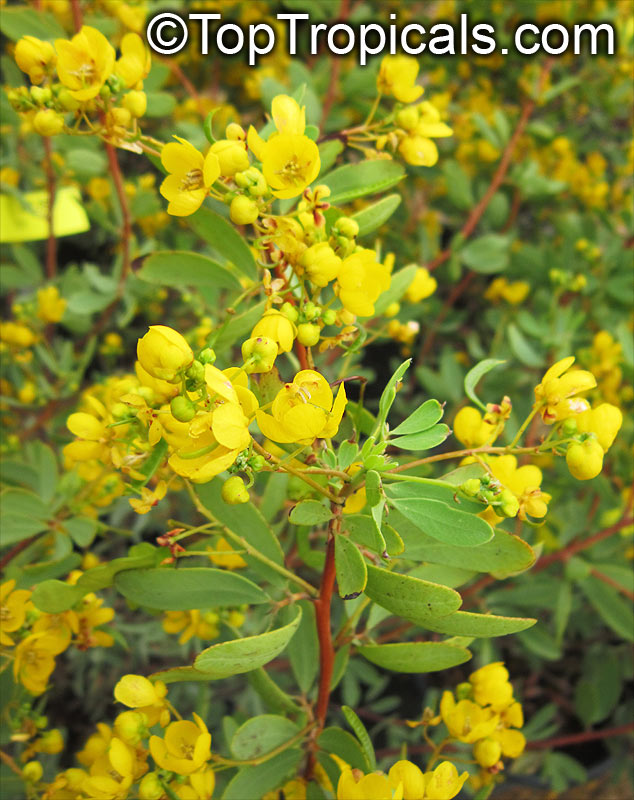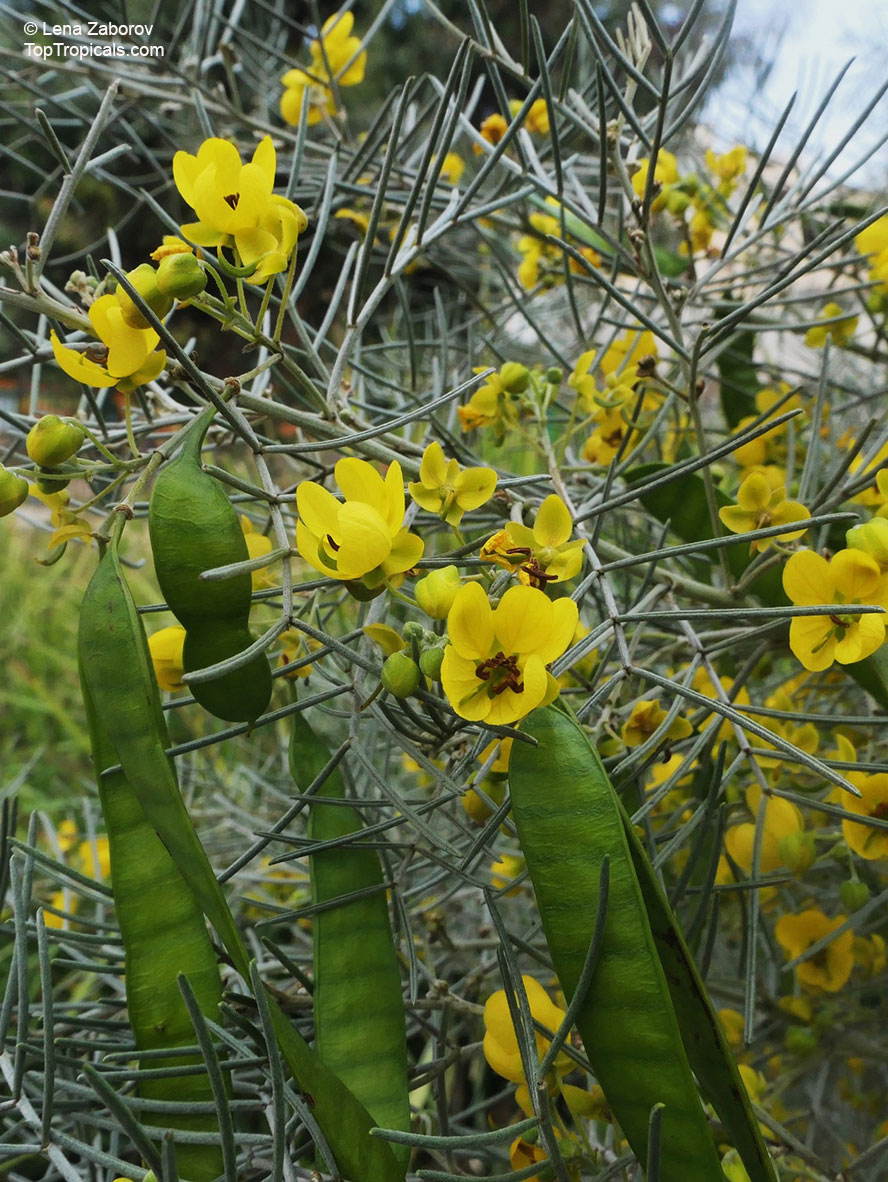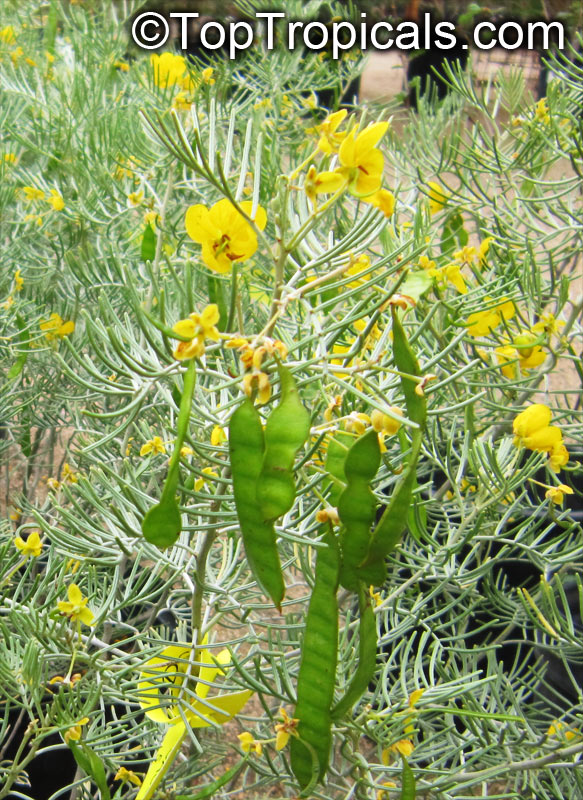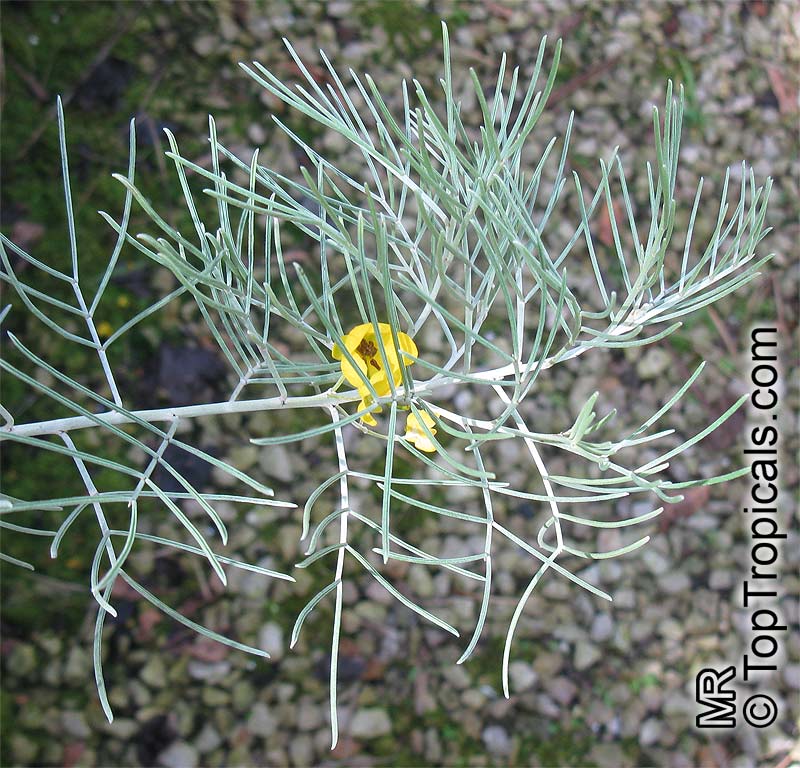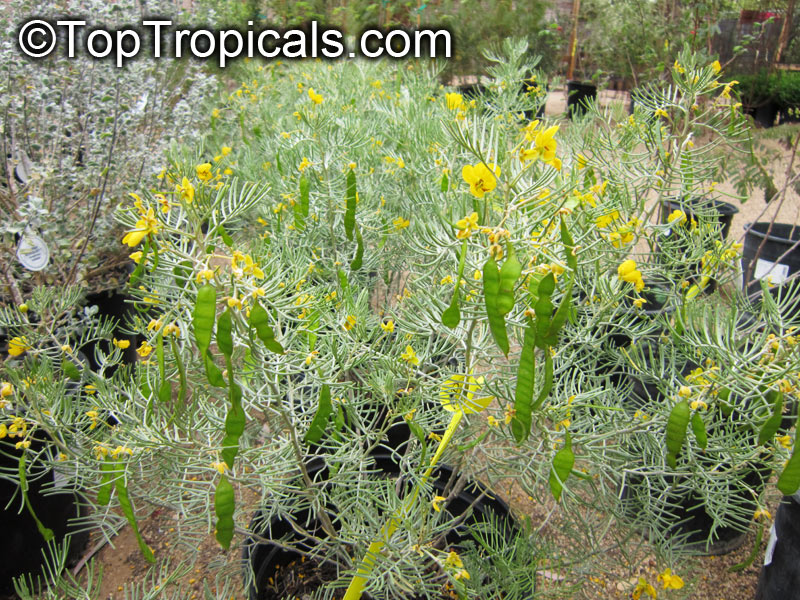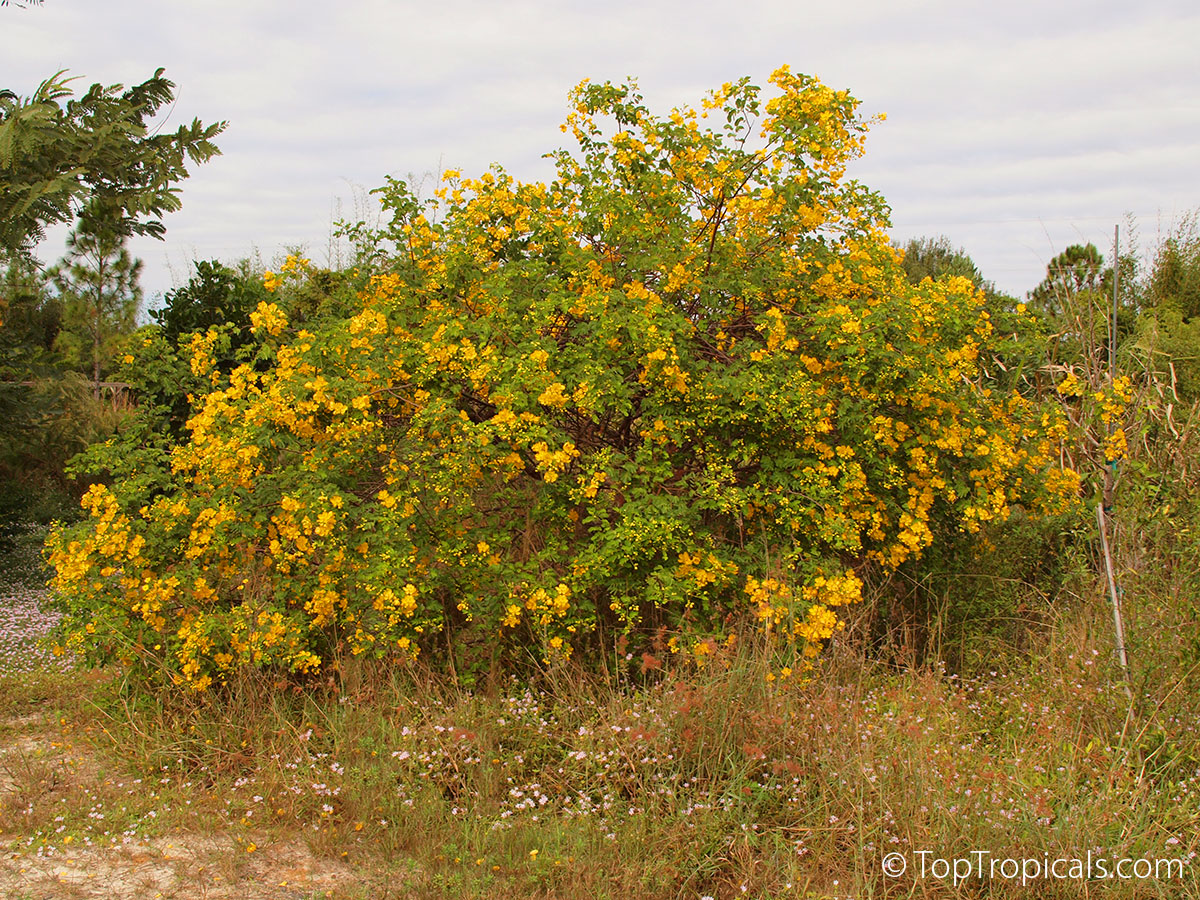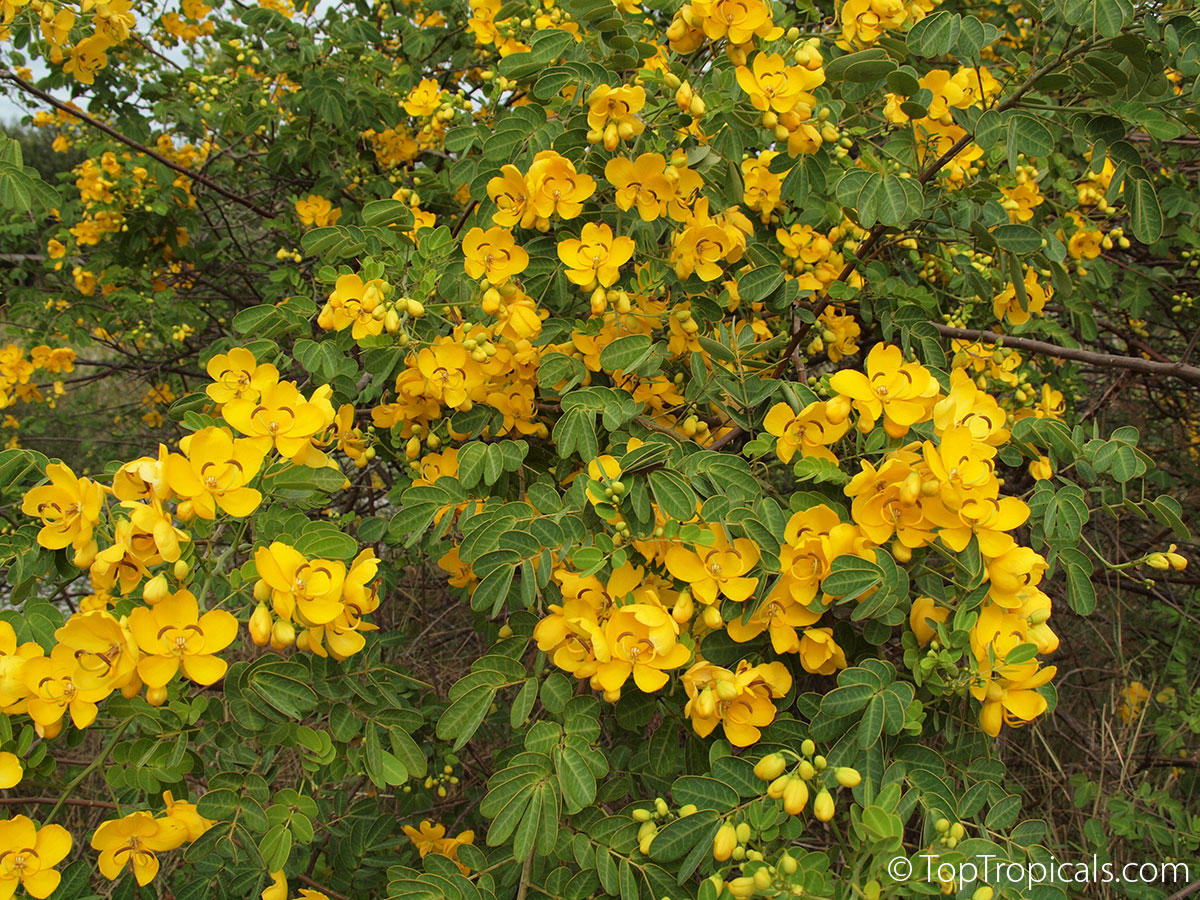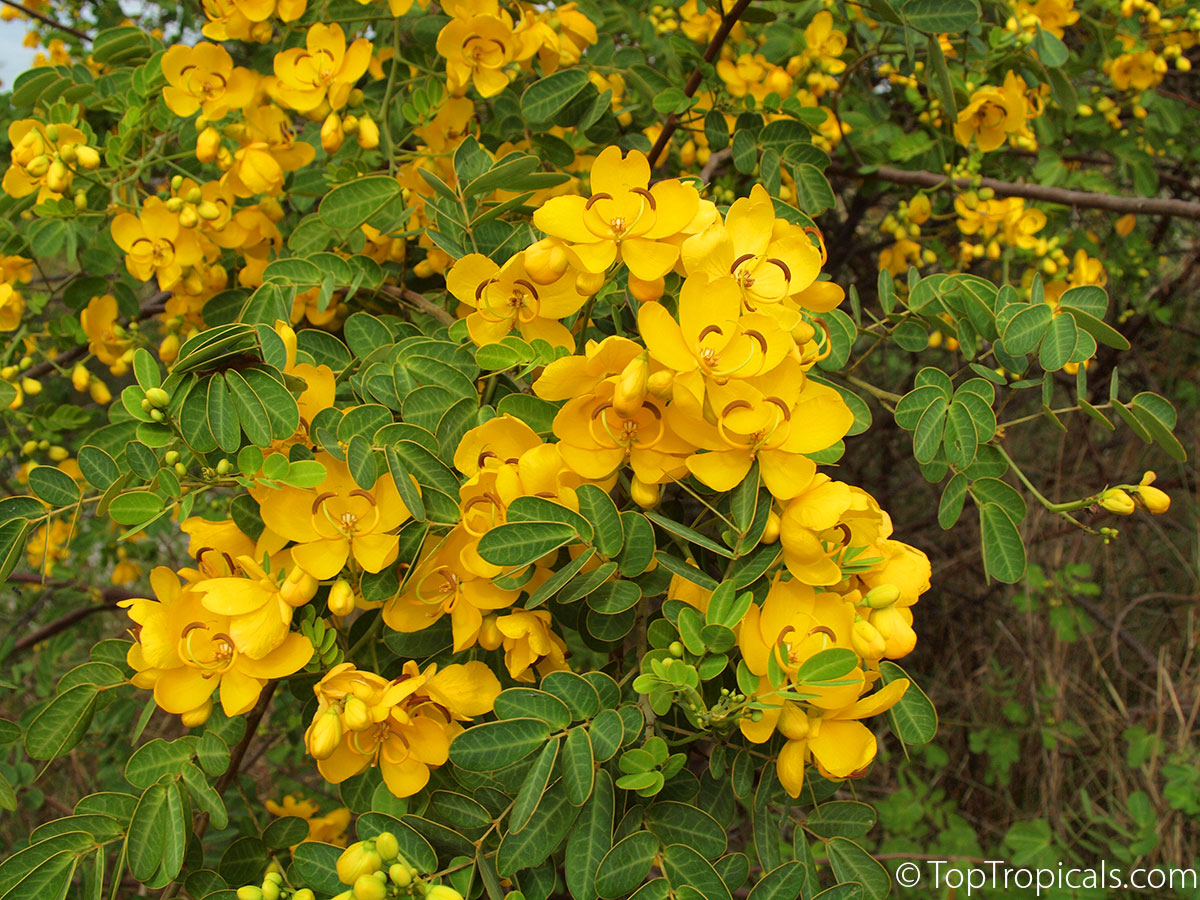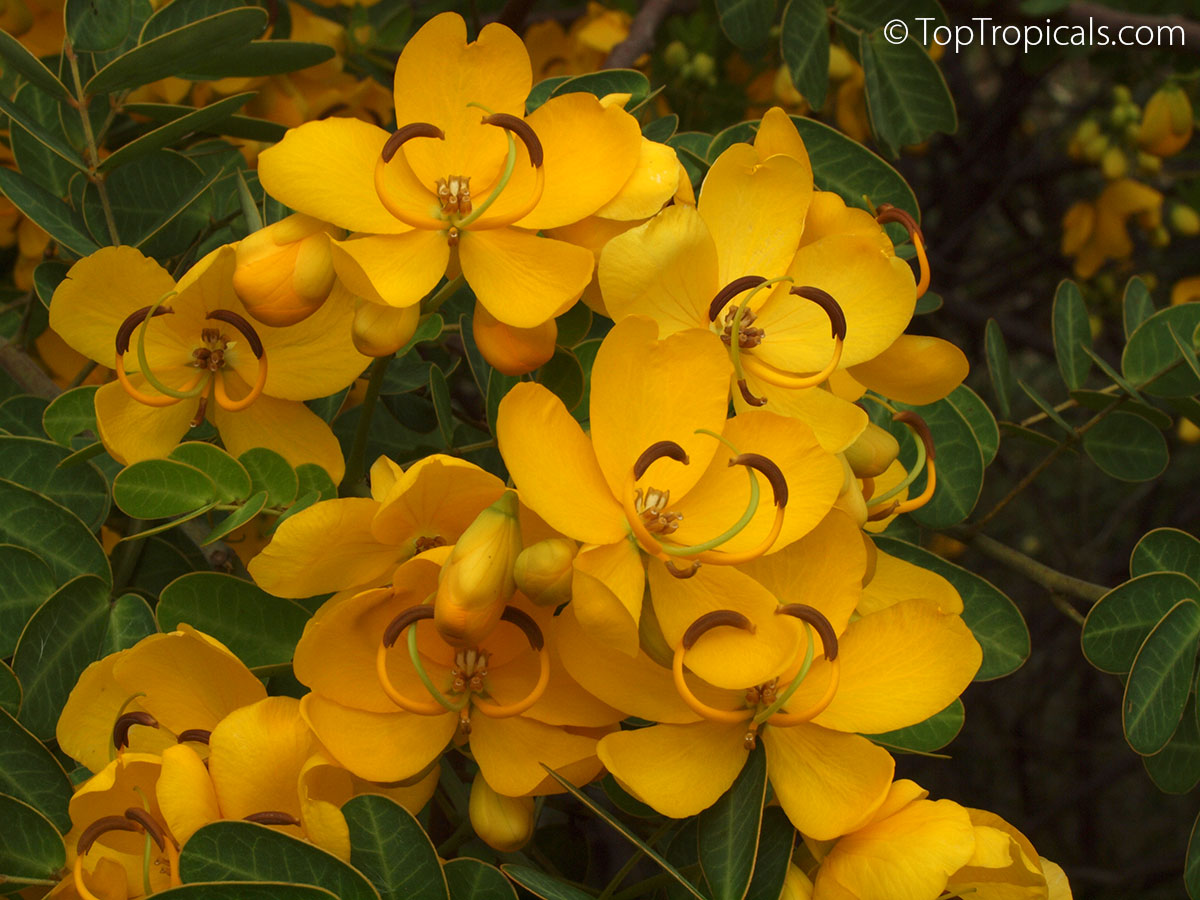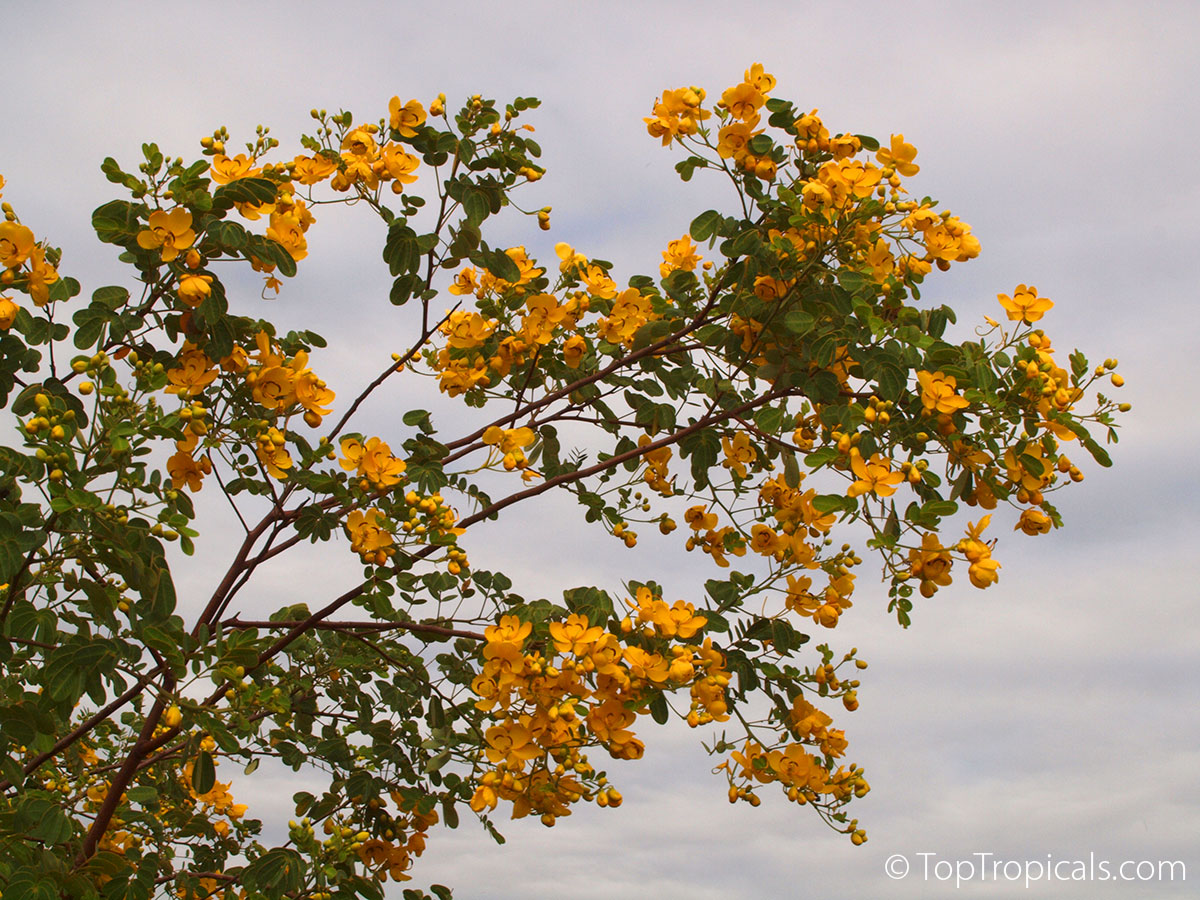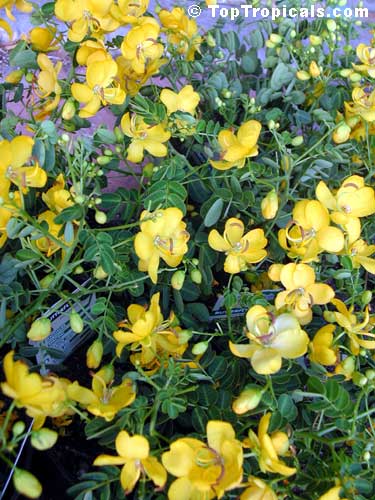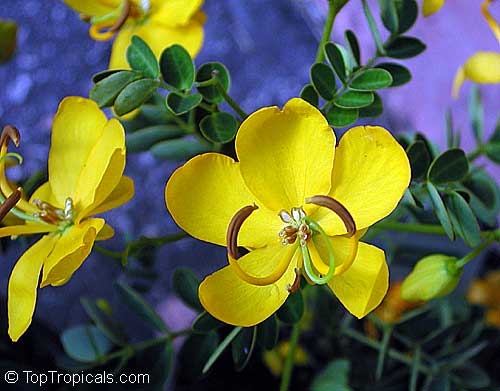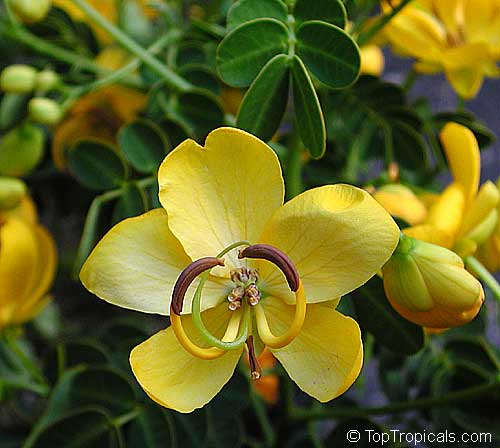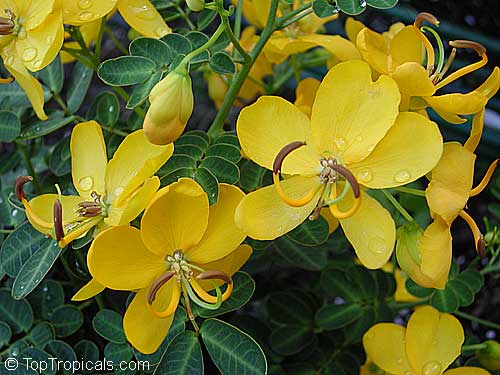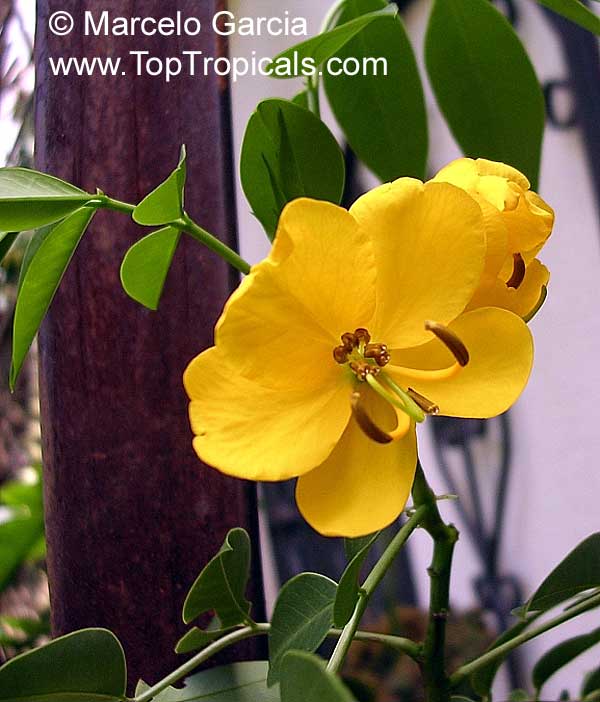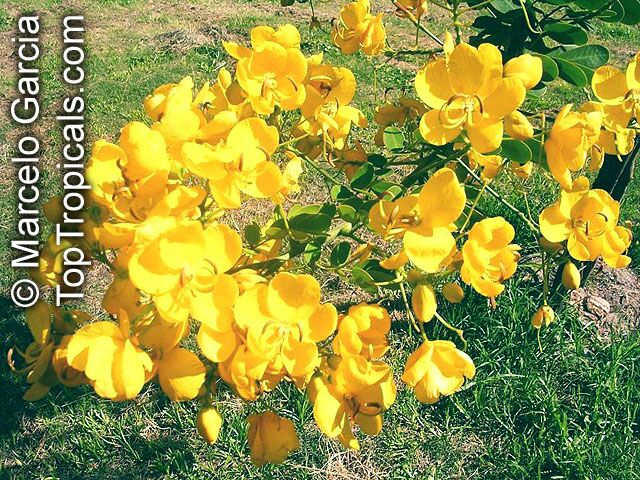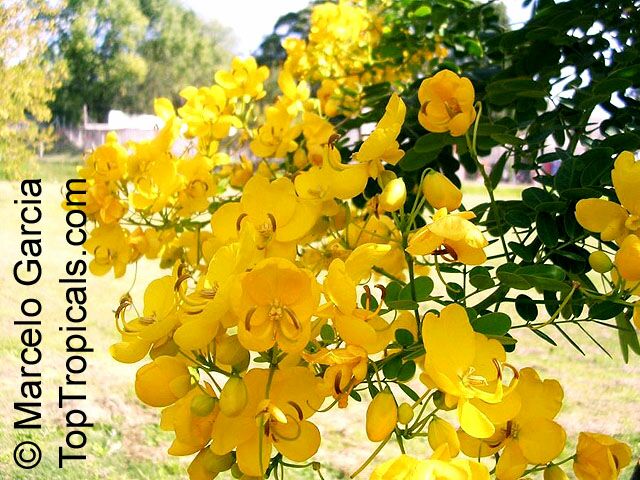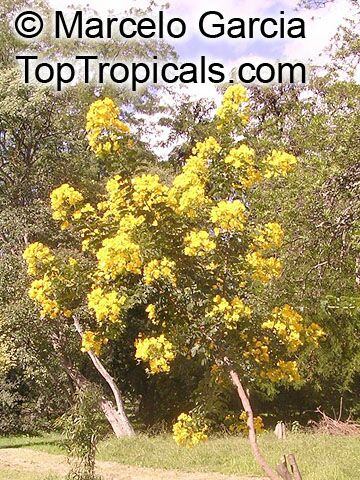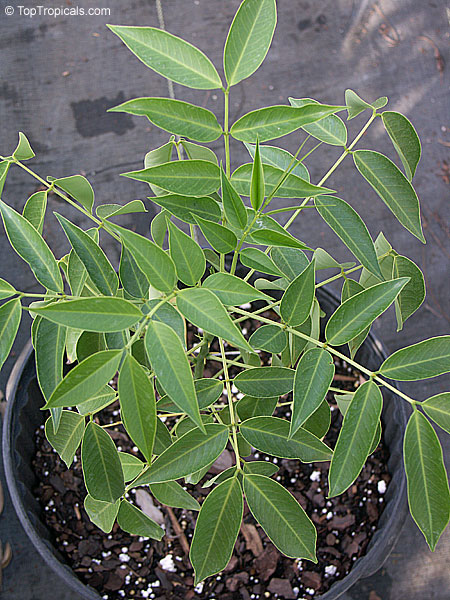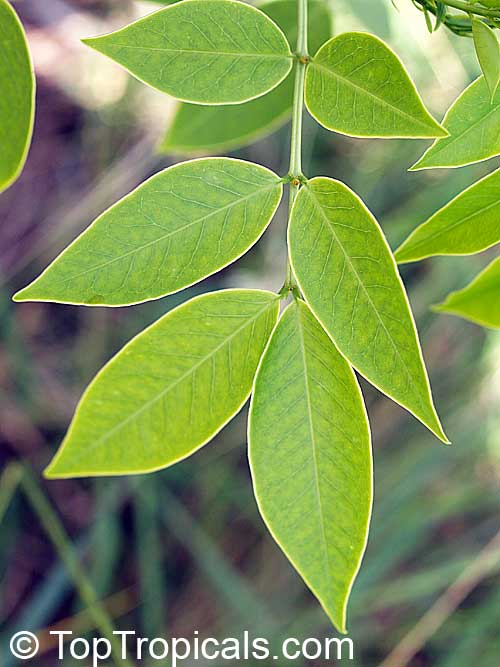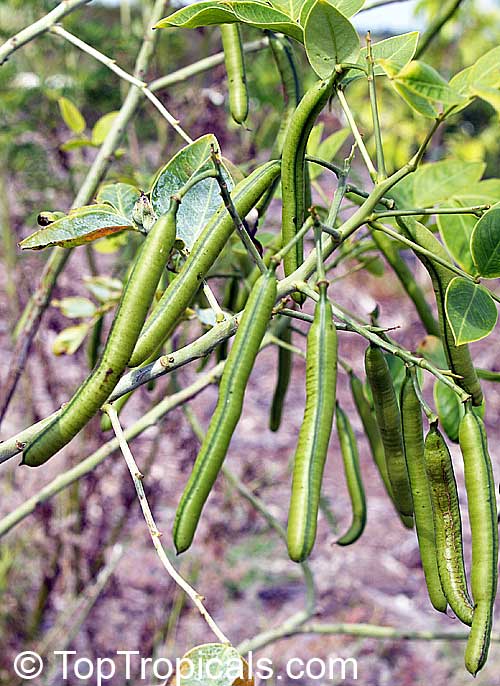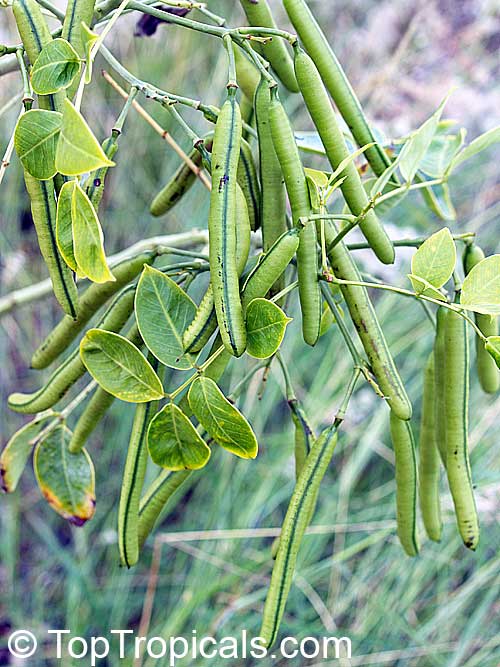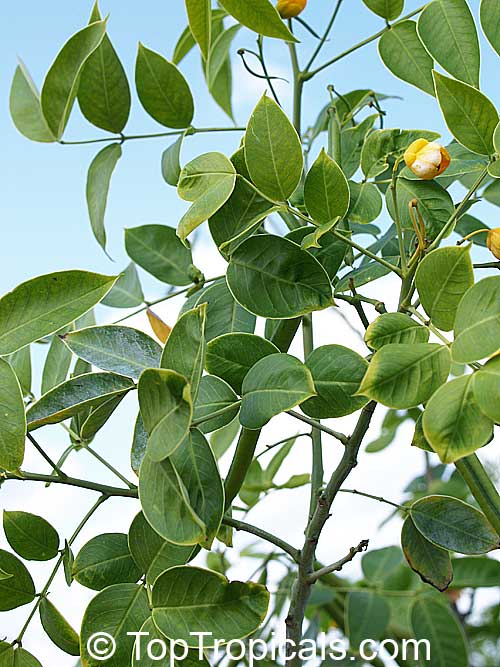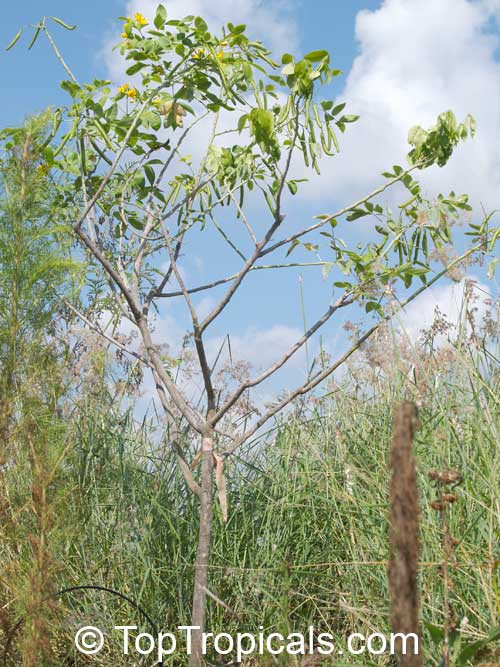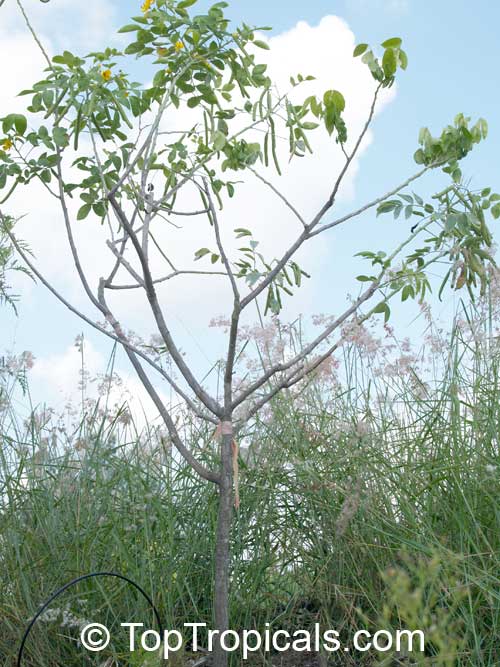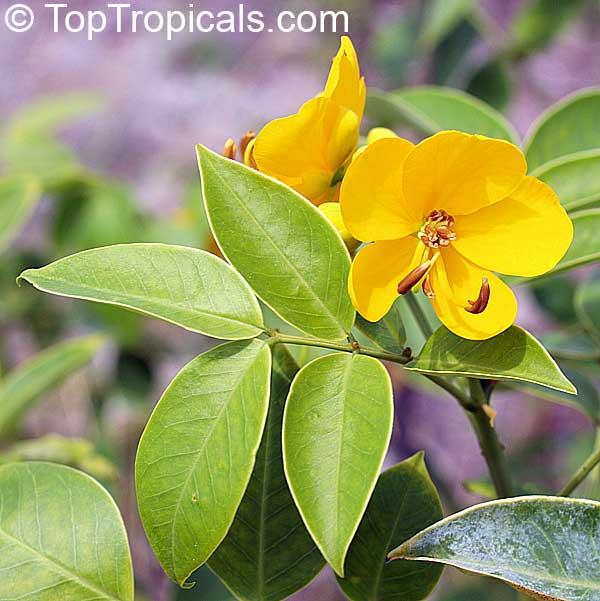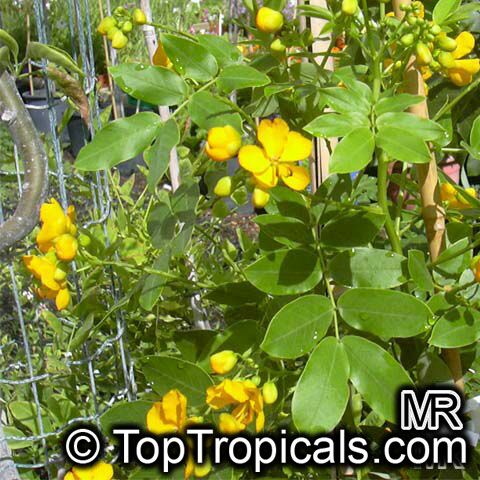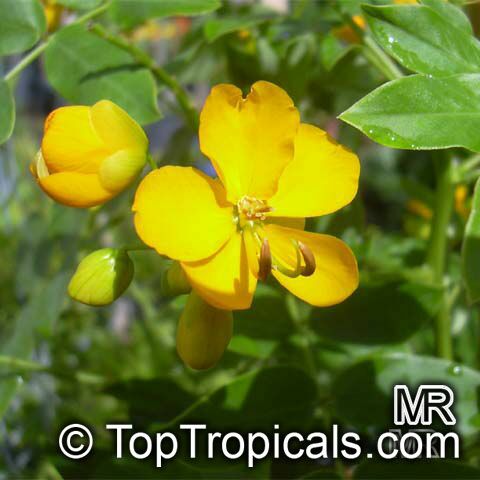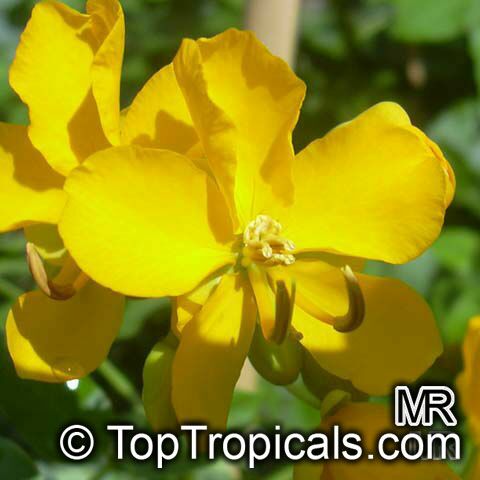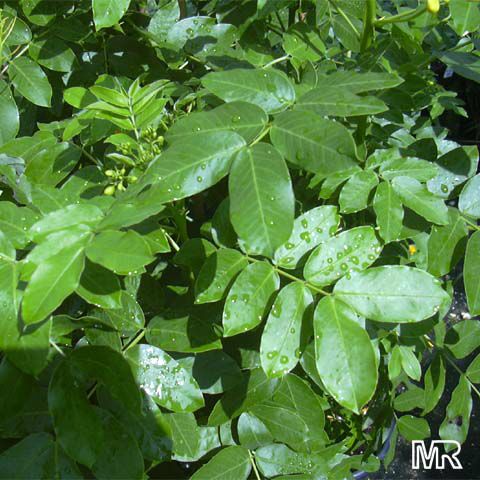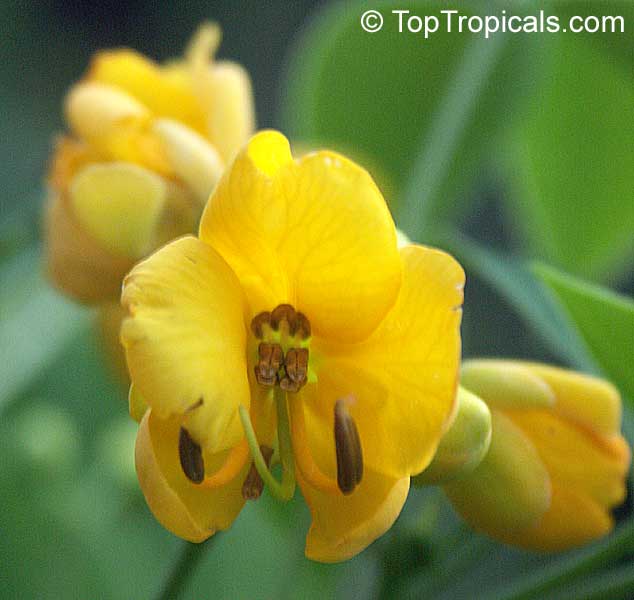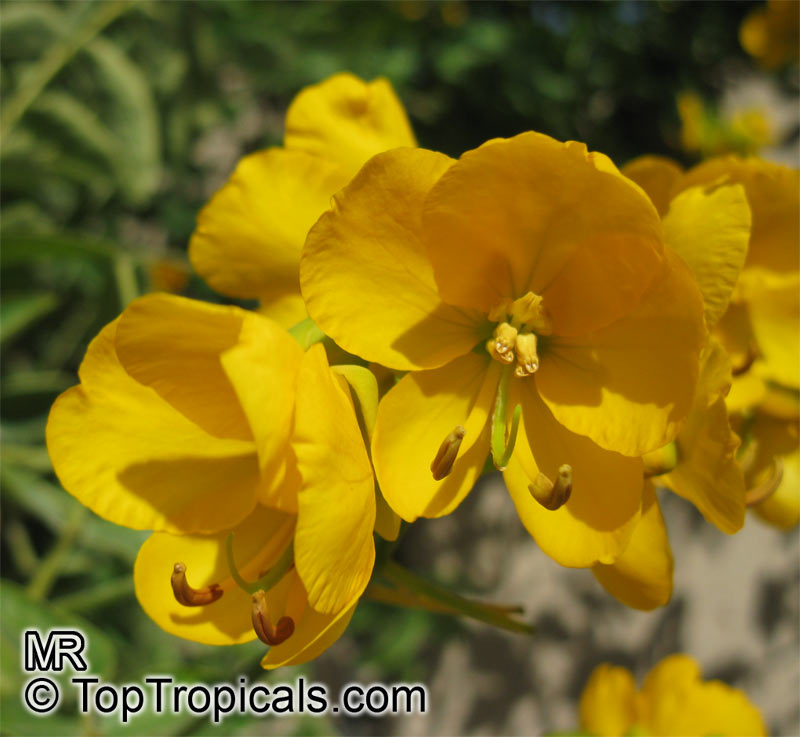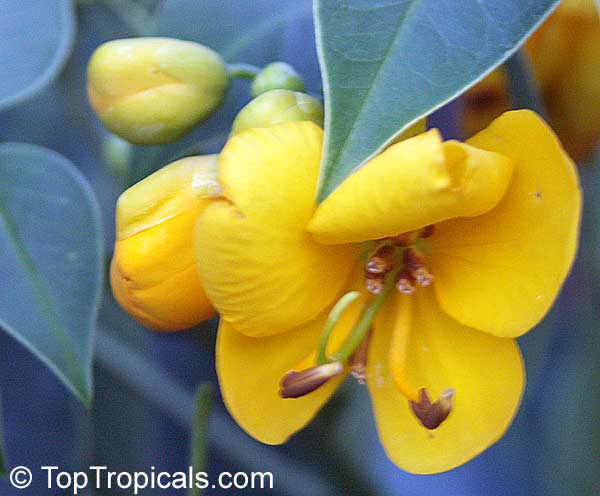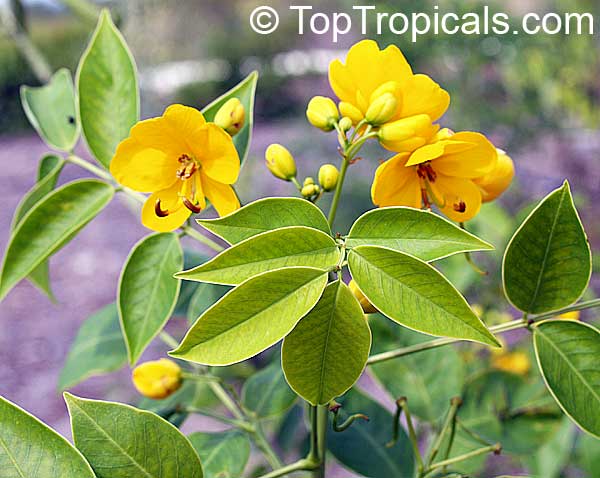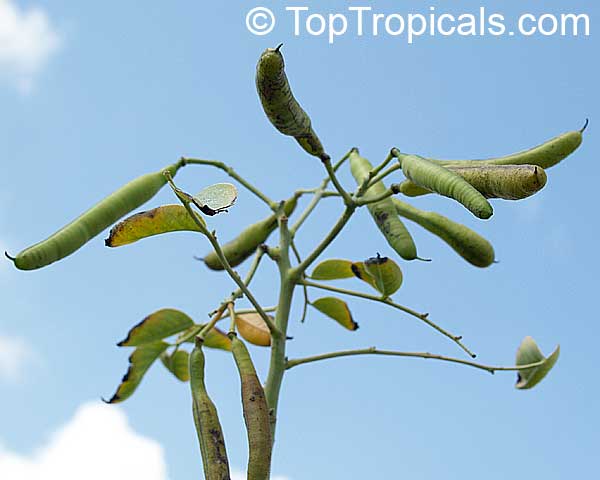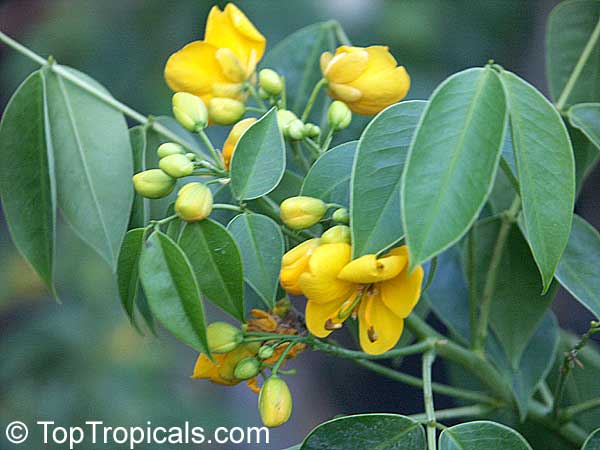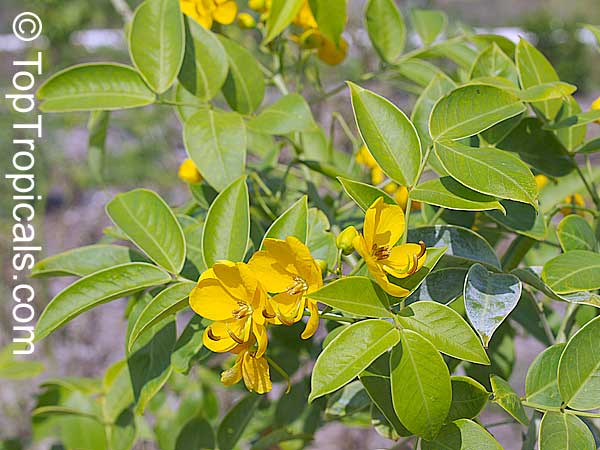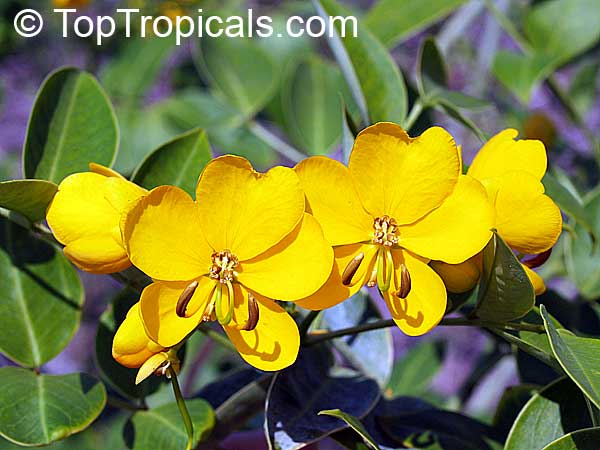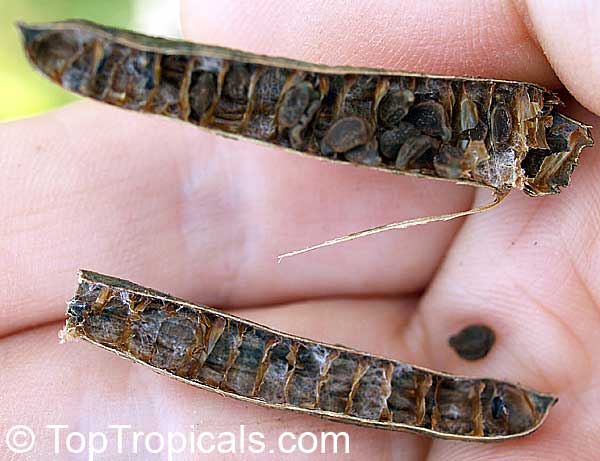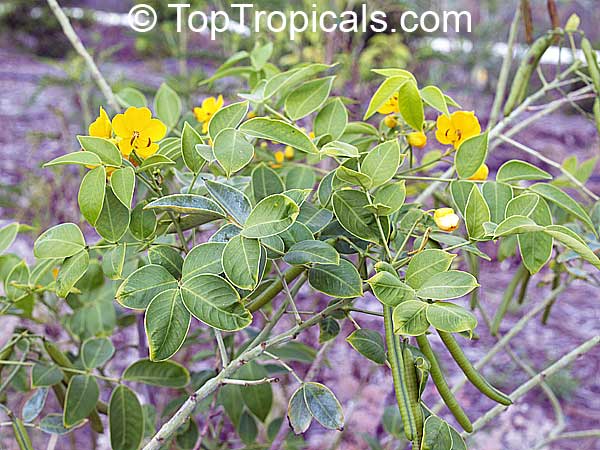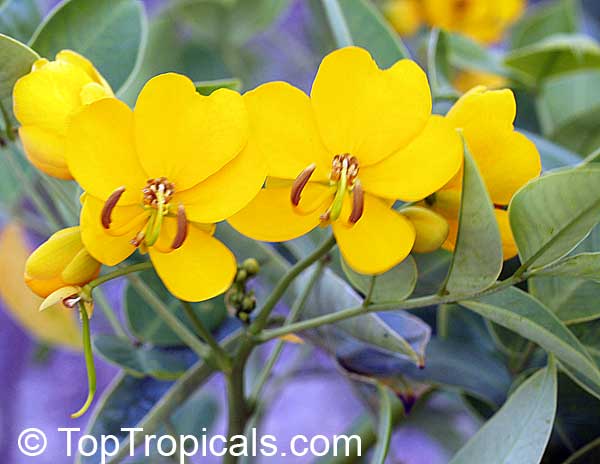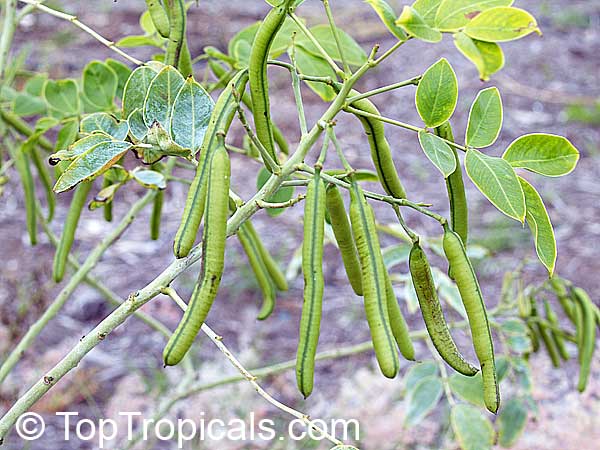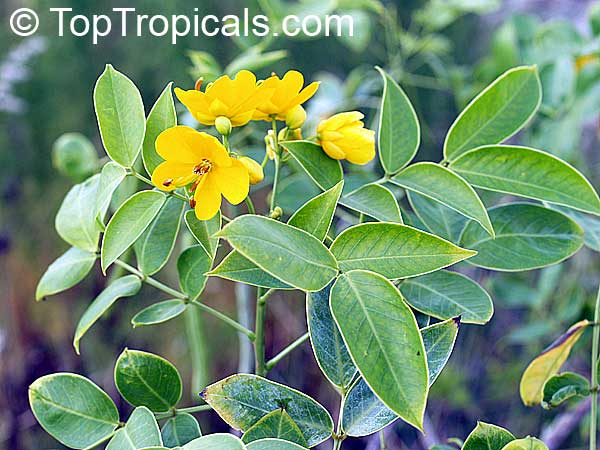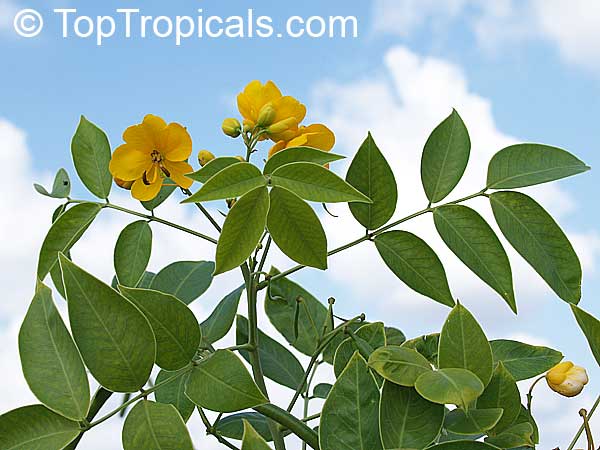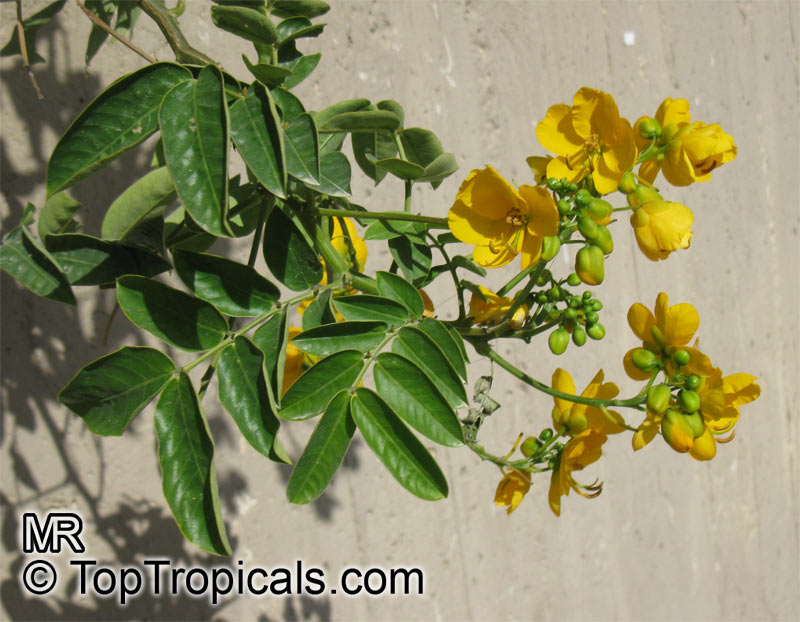Senna - Plant Encyclopedia Results
Top Tropicals Plant Encyclopedia
| Number of plants found: 23 | Next | 
|
Go to page: | 1 | 2 | 3 |
Botanical names: Cassia antillana, Senna nitida, Chamaefistula antillana, Cassia aurea
Common name: Golden Rain tree
Family: Fabaceae
Subfamily: Caesalpinioideae
Origin: South Asia





The growth habits of the Cassia antillana varies according to the climate in which it is grown. In USDA hardiness zones 9 through 11, it will grow as a large shrub 5 to 10 feet in height and 8 to 10 feet wide. In the warmer regions of zones 9 to 11, the Cassia antillana can reach the size of a small tree, 10 to 20 feet tall and wide. The tree can also be grown in a pot in cooler regions as long as it is brought indoors or placed in a sheltered location in the winter.
When grown outside, this tree thrives in full sun and regular watering. The foliage of the tree is delicate and a deep glossy green color. As the tree is in bloom, it produces sprays of drooping, yellow and orange flowers. These flowers remain on the tree for a long period of time, providing long-term interest in the garden.
Cassia antillana is an ideal choice for brightening up any spot in the garden. Requiring minimal care once established and thriving in both partial and full sun areas, this tree provides a beautiful focal point with its bright yellow and orange flowers. With regular watering and appropriate care, this tree will provide beauty in the garden for years to come.
Botanical names: Cassia bahamensis, Senna mexicana chapmanii
Common names: Bahama Senna, Bahama Cassia
Family: Fabaceae
Subfamily: Caesalpinioideae
Origin: Florida, Bahamas and Cuba







Cassia is a large genus with some 500 species. Cassia likes full sun and well-drained soil and to bloom profusely require a dry season.
Botanical names: Cassia occidentalis, Senna occidentalis, Cassia ligustrina
Common names: Coffee Senna, Fedegoso, Privet Cassia
Family: Fabaceae
Subfamily: Caesalpinioideae
Origin: South America







Medium size shrub or small tree with orange-yellow flowers from spring to fall. From distance, flowers look like little yellow hummingbirds and attract butterflies and bees. The plant is very ornamental not only due to its bloom but also to large, red-veined leaves.
Cassia occidentalis is a low-maintenance, medium-sized shrub that adds vibrant beauty and practical benefits to your landscape. From spring to fall, it produces clusters of orange-yellow flowers that attract butterflies and bees, while its large, red-veined leaves provide ornamental appeal year-round. Thriving in full sun to partial shade, this drought- and cold-tolerant plant is perfect for gardeners seeking beauty with minimal care. Its spreading habit also makes it ideal for creating natural hedges or privacy screens. Named for its coffee bean-like seeds, Coffee Senna is part of the Senna genus, known for its medicinal uses. Beyond aesthetics, it offers health benefits, including digestive aid, respiratory support, skin health, and a rich source of iron and minerals.
Ordering seeds info
RECOMMENDED SUPPLIES:
Seed Germination Mix #3, professional grade
SUNSHINE-Epi - Seeds and cuttings booster
SUNSHINE Bombino - Young Plant Booster
Botanical names: Cassia spectabilis, Senna spectabilis, Senna macranthera
Common names: Cassia, Scented Shower
Family: Fabaceae
Subfamily: Caesalpinioideae
Origin: South-East Asia









Cassia spectabilis requires full sun for best growth although it will tolerate semi-shade, with regular water in summer and occasional water in winter. The mature plant is cold hardy at least to low 30s F (0C) for a short time. When grown in a pot, the soil should be allowed to dry out slightly between waterings. It is best not to over-water it. It is a tropical species, native to the South-East Asia, that grows to 10-20 feet tall in USDA Zones 9-11. It produces very showy yellow and orange flowers, which are fragrant and attract butterflies and hummingbirds.
This ornamental plant is tolerant of pruning and can make an excellent hedge/bower or a trellis as it clings easily and is moderate fast growing. It can be maintained at a lower height as well. Cassia spectabilis needs a sheltered position, preferrably with a south or south-east facing aspect when grown in cold regions. In cold regions it is best to bring the potted plant indoors in winter or to insulate the pot for additional cold protection. Cassia spectabilis is an outstanding, long-blooming, cold hardy and easy to grow tropical tree or large shrub, ideal for both home and landscape gardens.
Botanical names: Senna alata, Cassia alata
Common names: Empress candle plant, Candle Bush, Carrion Crow Bush, Candlesticks, Candelabra Plant
Family: Fabaceae
Subfamily: Caesalpinioideae
Origin: South America









Empress Candle is a true garden wonder. Imagine a plant that grows fast, almost always has flowers, and covers large spaces with its lush leaves and beautiful blooms. Its huge leaves create nice cool shade for many feet around it which keeps weeds away. The plant grows up to 10 ft wide and 6-8 feet tall just in 1-2 seasons providing full sun and regular water.
The Empress Candle stands out for its rapid growth and non-stop blooming. Its green leaves shine in the sun, and its candle-like flowers add bursts of color and a sweet scent that bees and butterflies can't resist. The beauty of this plant also attracts hummingbirds and other pollinators.
What's truly special is how it turns your garden into a living masterpiece. It quickly spreads across the space, creating a vibrant picture of nature's beauty.
For any gardener, Senna alata is a must. It's like having a piece of nature's art that keeps shining and blooming, making your garden a breathtaking sight.
Senna alata is an ethnomedical plant, meaning it has many medicinal uses. In particular, the antibacterial and antifungal activities of the flowers have been used to treat tinea versicolor and ringworm infections.
Watch video about Empress Candle.
Recommended Fertilizer: SUNSHINE Megaflor - Bloom Nutrition Booster
Ordering seeds info
RECOMMENDED SUPPLIES:
Seed Germination Mix #3, professional grade
SUNSHINE-Epi - Seeds and cuttings booster
SUNSHINE Bombino - Young Plant Booster
Botanical name: Senna artemisioides
Common name: Grey Cassia
Cultivar: Sturtii
Family: Fabaceae
Subfamily: Caesalpinioideae
Origin: Australia







Small shrub to 1.5m with grey foliage. Grows scattered on red sandy soils and stony ridges. Good garden shrub.
Botanical name: Senna artemisioides
Common name: Outback Cassia
Cultivar: Oligophylla
Family: Fabaceae
Subfamily: Caesalpinioideae
Origin: Australia





Senna artemisioides subsp. oligophylla, also known as Outback Cassia, is a small shrub native to Australia. It has glossy green leaves and reddish stems, and boasts bright yellow flowers in the spring. After a few weeks, the orange-red seedpods are left behind, providing an attractive ornament to your garden. It can grow to be a couple of feet tall, making it suitable for those who have limited space.
This perennial flower is easy to care for and can tolerate a range of conditions. It prefers full sun to semi-shaded spots, and prefers moderate watering to keep its soil damp but not waterlogged. It can be grown in USDA zones 9-11, and it will flaunt its bright flowers from late April to June.
If you happen to live in a cooler place, Outback Cassia can still be enjoyed from the comfort of your home. You can make it grow indoors in a pot, however you'll need to provide it with some extra attention. Place your pot in a location that will receive between 2-4 hours of sunlight a day to replicate the conditions of its native environment. Keep the soil damp but not waterlogged, and feed it with a balanced fertilizer every few months.
Outback Cassia is a unique and versatile perennial flower, perfect for both experienced and novice gardeners. Its hardy nature, colorful bloom, and interesting seedpods make it a delightful addition to any garden.
Botanical name: Senna artemisioides
Common names: Dense senna, Grey Desert Senna
Cultivar: Artemisioides
Family: Fabaceae
Subfamily: Caesalpinioideae
Origin: Central Australia




Silvery-grey quick-growing shrub with scented golden-yellow flowers in winter. Propagation: Seeds
Botanical names: Senna bicapsularis, Cassia bicapsularis, Cassia sennoides
Common names: Butterfly Cassia, Butterfly Bush, Winter Cassia
Family: Fabaceae
Subfamily: Caesalpinioideae
Origin: Panama







Evergreen large shrub, or small tree, fast growing 8 to 12 feet tall, 8 to 10 feet spread. Light yellow to deep golden yellow buttercup-shaped flowers, with prominent curved stamens, appearing in large sprays, over a long period in autumn and winter.
Botanical names: Senna corymbosa, Cassia falcata
Common names: Southern Cassia, Flowery Senna, Argentina Senna
Family: Fabaceae
Subfamily: Caesalpinioideae
Origin: Argentina, Brazil and Uruguay






Senna corymbosa is one of a family of over 500 species of trees, shrubs, perennial herbs and annuals that make up the family of Cassias/Sennas, most of which come from the Tropics. Senna corymbosa is from sub-tropical South America and is designated Zone 8. It is a shrub or small tree growing in nature to around 12 ft producing racemes of golden-yellow flowers through the Summer months. It is suitable for pot cultivation for the patio or conservatory. Perfectly grows and blooms in containers due to its slow growth habit and won't overgrow the pot. Perfect for a sunny patio.
This plant was previously misnamed as Cassia odorata.
| Next |  |
Use link to repeat this search:
https://toptropicals.com/cgi-bin/garden_catalog/cat.cgi?find=Senna&search_op=and&keyword_op=and&language=e&number=10
&no_change_lang=1&user=tt&sale=1&first=0
